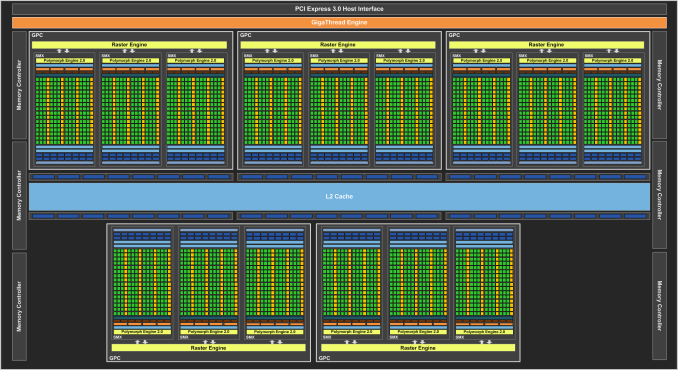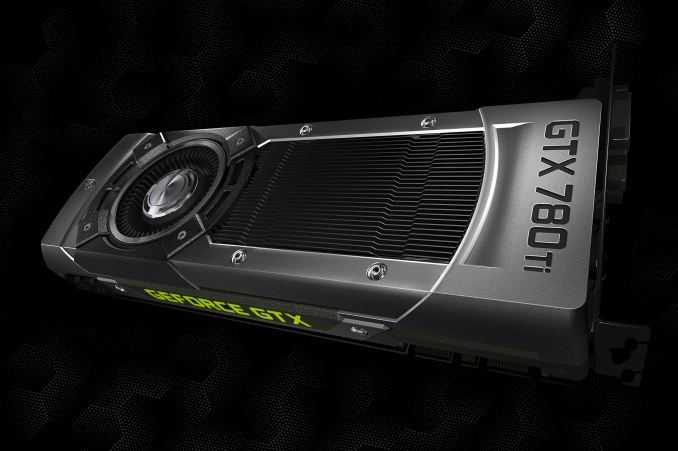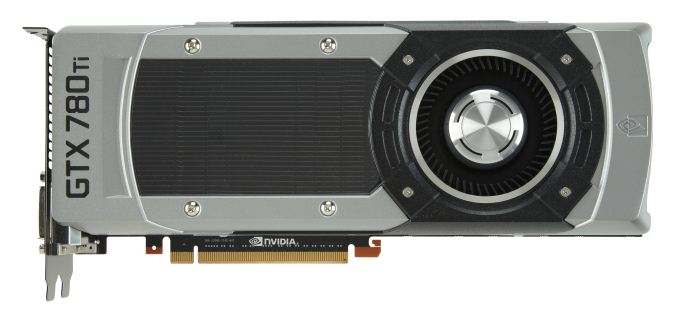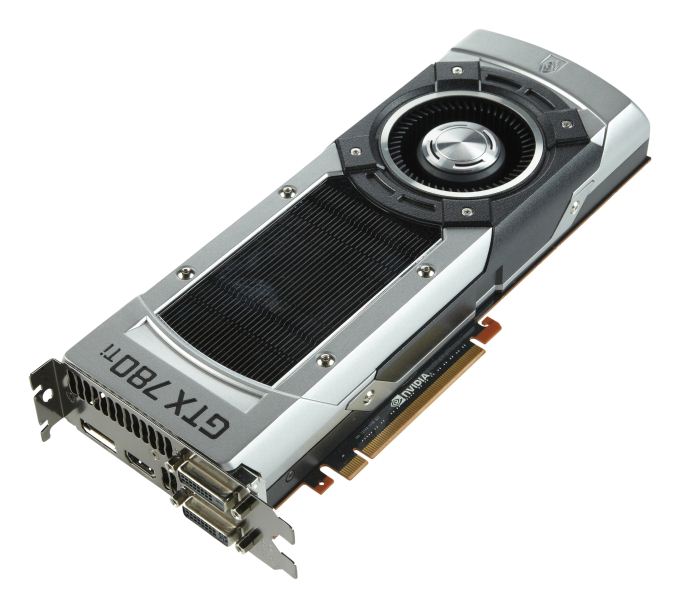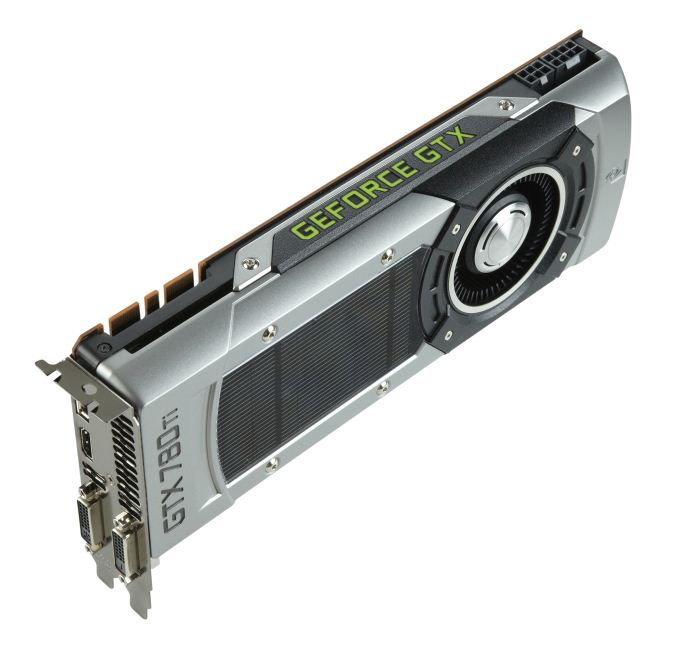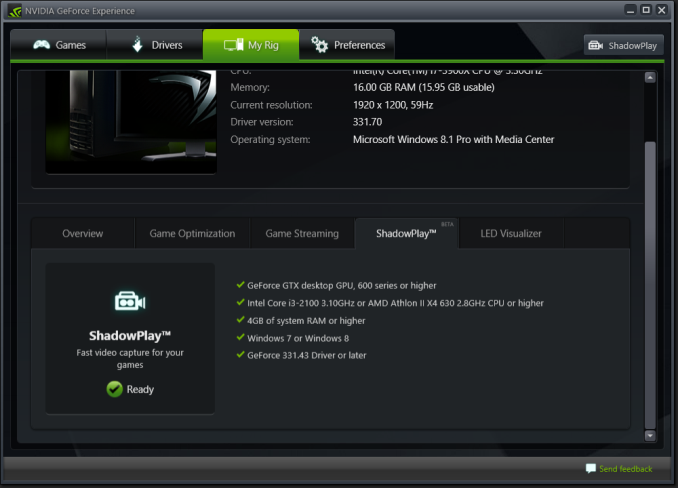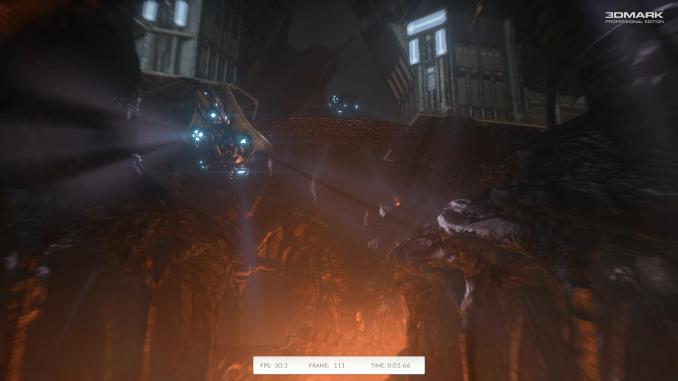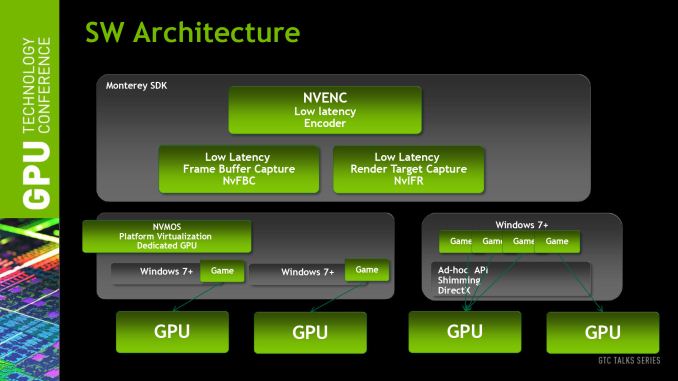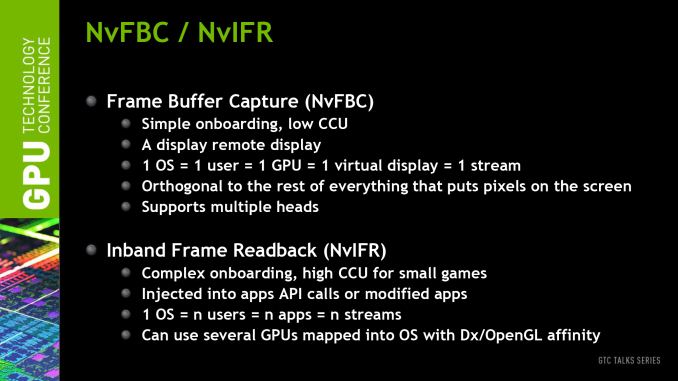
Original Link: https://www.anandtech.com/show/7492/the-geforce-gtx-780-ti-review
The NVIDIA GeForce GTX 780 Ti Review
by Ryan Smith on November 7, 2013 9:01 AM EST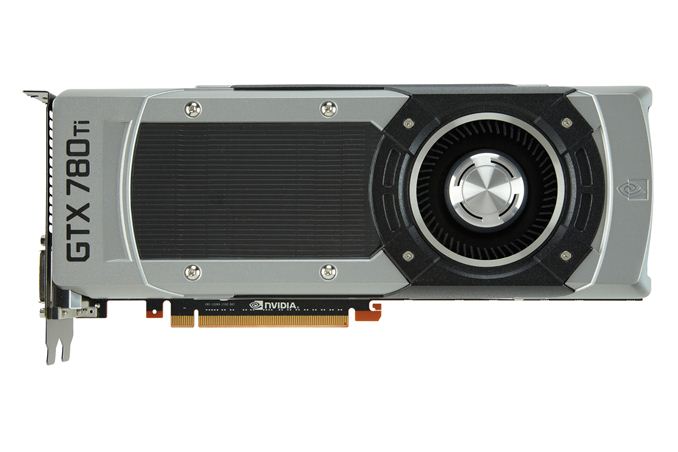
When NVIDIA launched their first consumer GK110 card back in February with the GeForce GTX Titan, one of the interesting (if frustrating) aspects of the launch was that we knew we wouldn’t be getting a “complete” GK110 card right away. GTX Titan was already chart-topping fast, easily clinching the crown for NVIDIA, but at the same time it was achieving those high marks with only 14 of GK110’s 15 SMXes active. The 15th SMX, though representing just 7% of GK110’s compute/geometry hardware, offered the promise of just a bit more performance out of GK110, and a promise that would have to wait to be fulfilled another day. For a number of reasons, NVIDIA would keep a little more performance in the tank in reserve for use in the future.
Jumping forward 8 months to the past few weeks, and things have significantly changed in the high-end video card market. With the launch of AMD’s new flagship video card, Radeon R9 290X, AMD has unveiled the means to once again compete with NVIDIA at the high end. And at the same time they have shown that they have the wherewithal to get into a fantastic, bloody price war for control of the high-end market. Right out of the gate 290X was fast enough to defeat GTX 780 and battle GTX Titan to a standstill, at a price hundreds of dollars cheaper than NVIDIA’s flagship card. The outcome of this has been price drops all around, with GTX 780 shedding $150, GTX Titan being all but relegated to the professional side of “prosumer,” and an unexpectedly powerful Radeon R9 290 practically starting the same process all over again just 2 weeks later.
With that in mind, NVIDIA has long become accustomed to controlling the high-end market and the single-GPU performance crown. AMD and NVIDIA may go back and forth at times, but at the end of the day it’s usually NVIDIA who comes out on top. So with AMD knocking at their door and eyeing what has been their crown, the time has come for NVIDIA to tap their reserve tank and to once again cement their hold. The time has come for GTX 780 Ti.
| GTX 780 Ti | GTX Titan | GTX 780 | GTX 770 | |
| Stream Processors | 2880 | 2688 | 2304 | 1536 |
| Texture Units | 240 | 224 | 192 | 128 |
| ROPs | 48 | 48 | 48 | 32 |
| Core Clock | 875MHz | 837MHz | 863MHz | 1046MHz |
| Boost Clock | 928Mhz | 876Mhz | 900Mhz | 1085MHz |
| Memory Clock | 7GHz GDDR5 | 6GHz GDDR5 | 6GHz GDDR5 | 7GHz GDDR5 |
| Memory Bus Width | 384-bit | 384-bit | 384-bit | 256-bit |
| VRAM | 3GB | 6GB | 3GB | 2GB |
| FP64 | 1/24 FP32 | 1/3 FP32 | 1/24 FP32 | 1/24 FP32 |
| TDP | 250W | 250W | 250W | 230W |
| Transistor Count | 7.1B | 7.1B | 7.1B | 3.5B |
| Manufacturing Process | TSMC 28nm | TSMC 28nm | TSMC 28nm | TSMC 28nm |
| Launch Date | 11/07/13 | 02/21/13 | 05/23/13 | 05/30/13 |
| Launch Price | $699 | $999 | $649 | $399 |
Getting right down to business, GeForce GTX 780 Ti unabashedly a response to AMD’s Radeon R9 290X while also serving as NVIDIA’s capstone product for the GeForce 700 series. With NVIDIA finally ready and willing to release fully enabled GK110 based cards – a process that started with Quadro K6000 – GTX 780 Ti is the obligatory and eventual GeForce part to bring that fully enabled GK110 GPU to the consumer market. By tapping the 15th and final SMX for a bit more performance and coupling it with a very slight clockspeed bump, NVIDIA has the means to fend off AMD’s recent advance while offering a refresh of their product line just in time for a busy holiday season and counter to the impending next-generation console launch.
Looking at the specifications for GTX 780 Ti in detail, at the hardware level GTX 780 Ti is the fully enabled GK110 GeForce part we’ve long been waiting for. Featuring all 15 SMXes up and running, GTX 780 Ti features 25% more compute/geometry/texturing hardware than the GTX 780 it essentially replaces, or around 7% more hardware than the increasingly orphaned GTX Titan. To that end the only place that GTX 780 Ti doesn’t improve on GTX Titan/780 is in the ROP department, as both of those cards already featured all 48 ROPs active, alongside the associated memory controllers and L2 cache.
Coupled with the fully enabled GK110 GPU, NVIDIA has given GTX 780 Ti a minor GPU clockspeed bump to make it not only the fastest GK110 card overall, but also the highest clocked card. The 875MHz core clock and 928MHz boost clock is only 15MHz and 28MHz faster than GTX 780 in their respective areas, but with GTX 780 already being clocked higher than GTX Titan, GTX 780 Ti doesn’t need much more in the way of GPU clockspeed to keep ahead of the competition and its older siblings. As a result if we’re comparing GTX 780 Ti to GTX 780, then GTX 780 relies largely on its SMX advantage to improve performance, combining a 1% clockspeed bump and a 25% increase in shader harder to offer 27% better shading/texturing/geometry performance and just 1% better ROP throughput than GTX 780. Or to compare things to Titan, then GTX 780 Ti relies on its more significant 5% clockspeed advantage coupled with its 7% functional unit increase to offer a 12% increase in shading/texturing/geometry performance, alongside a 5% increase in ROP throughput.
With specs and numbers in mind, there is one other trick up GTX 780 Ti’s sleeve to help push it past everything else, and that is a higher 7GHz memory clock. NVIDIA has given GK110 the 7GHz GDDR5 treatment with the GTX 780 Ti (making it the second card after GTX 770 to get this treatment), giving GTX 780 Ti 336GB/sec of memory bandwidth. This is 17% more than either GTX Titan or GTX 780, and even edging out the recently released Radeon R9 290X’s 320GB/sec. The additional memory bandwidth, though probably not absolutely necessary from what we’ve seen with GTX Titan, will help NVIDIA get as much out of GK110 as they can and further separate the card from other NVIDIA and AMD cards alike.
The only unfortunate news here when it comes to memory will be that unlike Titan, NVIDIA is sticking with 3GB for the default RAM amount on GTX 780 Ti. Though the performance ramifications of this will be minimal (at least at this time), will put the card in an odd spot of having less RAM than the cheaper Radeon R9 290 series.
Taken altogether then, GTX 780 Ti stands to be anywhere between 1% and 27% faster than GTX 780 depending on whether we’re looking at a ROP-bound or shader-bound scenario. Otherwise it stands to be between 5% and 17% faster than GTX Titan depending on whether we’re ROP-bound or memory bandwidth-bound.
Meanwhile let’s quickly talk about power consumption. As GTX 780 Ti is essentially just a spec bump of the GK110 hardware we’ve seen for the last 8 months, power consumption won’t officially be changing. NVIDIA designed GTX Titan and GTX 780 with the same power delivery system and the same TDP limit, with GTX 780 Ti further implementing the same system and the same limits. So officially GTX 780 Ti’s TDP stands at 250W just like the other GK110 cards. Though in practice power consumption for GTX 780 Ti will be higher than either of those other cards, as the additional performance it affords will mean that GTX 780 Ti will be on average closer to that 250W limit than either of those cards.
Finally, let’s talk about pricing, availability, and competitive positioning. On a pure performance basis NVIDIA expects GTX 780 Ti to be the fastest single-GPU video card on the market, and our numbers back them up on this. Consequently NVIDIA is going to be pricing and positioning GTX 780 Ti a lot like GTX Titan/780 before it, which is to say that it’s going to be priced as a flagship card rather than a competitive card. Realistically AMD can’t significantly threaten GTX 780 Ti, and although it’s not going to be quite the lead that NVIDIA enjoyed over AMD earlier this year, it’s enough of a lead that NVIDIA can pretty much price GTX 780 Ti based solely on the fact that it’s the fastest thing out there. And that’s exactly what NVIDIA has done.
To that end GTX 780 Ti will be launching at $699, $300 less than GTX Titan but $50 higher than the original GTX 780’s launch price. By current prices this will put it $150 over the R9 290X or $200 over the reprised GTX 780, a significant step over each. GTX 780 Ti will have the performance to justify its positioning, but just as the previous GK110 cards it’s going to be an expensive product. Meanwhile GTX Titan will be remaining at $999, despite the fact that it’s now officially dethroned as the fastest GeForce card (GTX 780 having already made it largely redundant). At this point it will live on as NVIDIA’s entry level professional compute card, keeping its unique FP64 performance advantage over the other GeForce cards.
Elsewhere on a competitive basis, until such a time where factory overclocked 290X cards hit the market, the only real single-card competition for GTX 780 Ti will be the Radeon HD 7990, AMD’s Tahiti based dual-GPU card, which these days retails for close to $800. Otherwise the closest competition will be dual card setups, such as the GTX 770 SLI, R9 280X CF, and R9 290 CF. All of those should present formidable challenges on a pure performance basis, though it will bring with it the usual drawbacks of multi-GPU rendering.
Meanwhile, as an added perk NVIDIA will be extending their recently announced “The Way It’s Meant to Be Played Holiday Bundle with SHIELD” promotion to the GTX 780 Ti, which consists of Assassins’ Creed IV, Batman: Arkham Origins, Splinter Cell: Blacklist, and a $100 SHIELD discount. NVIDIA has been inconsistent about this in the past, so it’s a nice change to see it included with their top card. As always, the value of bundles are ultimately up to the buyer, but for those who do place value in the bundle it should offset some of the sting of the $699 price tag.
Finally, for launch availability this will be a hard launch. Reference cards should be available by the time this article goes live, or shortly thereafter. It is a reference launch, and while custom cards are in the works NVIDIA is telling us they likely won’t hit the shelves until December.
| Fall 2013 GPU Pricing Comparison | |||||
| AMD | Price | NVIDIA | |||
| $700 | GeForce GTX 780 Ti | ||||
| Radeon R9 290X | $550 | ||||
| $500 | GeForce GTX 780 | ||||
| Radeon R9 290 | $400 | ||||
| $330 | GeForce GTX 770 | ||||
| Radeon R9 280X | $300 | ||||
| $250 | GeForce GTX 760 | ||||
| Radeon R9 270X | $200 | ||||
| $180 | GeForce GTX 660 | ||||
| $150 | GeForce GTX 650 Ti Boost | ||||
| Radeon R7 260X | $140 | ||||
Meet The GeForce GTX 780 Ti
When it comes to the physical design and functionality of the GTX 780 Ti, to no surprise NVIDIA is sticking with what works. The design of the GTX Titan and its associated cooler have proven themselves twice over now between the GTX Titan and the GTX 780, so with only the slightest of changes this is what NVIDIA is going with for GTX 780 Ti, too. Consequently there’s very little new material to cover here, but we’ll quickly hit the high points before recapping the general design of what has now become the GTX 780 series.
The biggest change here is that GTX 780 Ti is the first NVIDIA launch product to feature the new B1 revision of their GK110 GPU. B1 has already been shipping for a couple of months now, so GTX 780 Ti isn’t the first card to get this new GPU. However while GTX Titan and GTX 780 products currently contain a mix of the old and new revisions as NVIDIA completes the change-over, GTX 780 Ti will be B1 (and only B1) right out the door.
As for what’s new for B1, NVIDIA is telling us that it’s a fairly tame revision of GK110. NVIDIA hasn’t made any significant changes to the GPU, rather they’ve merely gone in and fixed some errata that were in the earlier revision of GK110, and in the meantime tightened up the design and leakage just a bit to nudge power usage down, the latter of which is helpful for countering the greater power draw from lighting up the 15th and final SMX. Otherwise B1 doesn’t have any feature changes nor significant changes in its power characteristics relative to the previous revision, so it should be a fairly small footnote compared to GTX 780.
The other notable change coming with GTX 780 Ti is that NVIDIA has slightly adjusted the default temperature throttle point, increasing it from 80C to 83C. The difference in cooling efficiency itself will be trivial, but since NVIDIA is using the exact same fan curve on the GTX 780 Ti as they did the GTX 780, the higher temperature throttle effectively increases the card’s equilibrium point, and therefore the average fan speed under load. Or put another way, but letting it get a bit warmer the GTX 780 Ti will ramp up its fan a bit more and throttle a bit less, which should help offset the card’s increased power consumption while also keeping thermal throttling minimized.
| GeForce GTX 780 Series Temperature Targets | ||||
| GTX 780 Ti Temp Target | GTX 780 Temp Target | GTX Titan Temp Target | ||
| 83C | 80C | 80C | ||
Moving on, since the design of the GTX 780 Ti is a near carbon copy of GTX 780, we’re essentially looking at GTX 780 with better specs and new trimmings. NVIDIA’s very effective (and still quite unique) metallic GTX Titan cooler is back, this time featuring black lettering and a black tinted window. As such GTX 780 Ti remains a 10.5” long card composed of a cast aluminum housing, a nickel-tipped heatsink, an aluminum baseplate, and a vapor chamber providing heat transfer between the GPU and the heatsink. The end result is the GTX 780 Ti is a quiet card despite the fact that it’s a 250W blower design, while still maintaining the solid feel and eye-catching design that NVIDIA has opted for with this generation of cards.
Drilling down, the PCB is also a re-use from GTX 780. It’s the same GK110 GPU mounted on the same PCB with the same 6+2 phase power design. This being despite the fact that GTX 780 Ti features faster 7GHz memory, indicating that NVIDIA was able to hit their higher memory speed targets without making any obvious changes to the PCB or memory trace layouts. Meanwhile the reuse of the power delivery subsystem is a reflection of the fact that GTX 780 Ti has the same 250W TDP limit as GTX 780 and GTX Titan, though unlike those two cards GTX 780 Ti will have the least headroom to spare and will come the closest to hitting it, due to the general uptick in power requirements from having 15 active SMXes. Finally, using the same PCB also means that GTX 780 has the same 6pin + 8pin power requirement and the same display I/O configuration of 2x DL-DVI, 1x HDMI, 1x DisplayPort 1.2.
On a final note, for custom cards NVIDIA won’t be allowing custom cards right off the bat – everything today will be a reference card – but with NVIDIA’s partners having already put together their custom GK110 designs for GTX 780, custom designs for GTX 780 Ti will come very quickly. Consequently, expect most (if not all of them) to be variants of their existing custom GTX 780 designs.
Hands On With NVIDIA's Shadowplay
Though it’s technically not part of the GeForce GTX 780 Ti launch, before diving into our typical collection of benchmarks we wanted to spend a bit of time looking at NVIDIA’s recently released Shadowplay utility.
Shadowplay was coincidentally enough first announced back at the launch of the GTX 780. Its designed purpose was to offer advanced game recording capabilities beyond what traditional tools like FRAPS could offer by leveraging NVIDIA image capture and video encode hardware. In doing so, Shadowplay would be able to offer similar capabilities with much less overhead, all the while also being able to utilize the NVENC hardware H.264 encoder to encode to space efficient H.264 rather than the bulky uncompressed formats traditional tools offer.
With Shadowplay and NVIDIA’s SHIELD streaming capabilities sharing so much of the underlying technology, the original plan was to launch Shadowplay in beta form shortly after SHIELD launched, however Shadowplay ended up being delayed, ultimately not getting its beta release until last week (October 28th). NVIDIA has never offered a full accounting for the delay, but one of the most significant reasons was because they were unsatisfied with their original video container choice, M2TS. M2TS containers, though industry standard and well suited for this use, have limited compatibility, with Windows Media Player in particular being a thorn in NVIDIA’s side. As such NVIDIA held back Shadowplay in order to convert it over to using MP4 containers, which have a very high compatibility rate at the cost of requiring some additional work on NVIDIA’s part.
In any case with the container issue resolved Shadowplay is finally out in beta, giving us our first chance to try out NVIDIA’s game recording utility. To that end while clearly still a beta and in need of further polishing and some feature refinements, at its most basic level we’ve come away impressed with Shadowplay, with NVIDIA having delivered on all of their earlier core promises for the utility
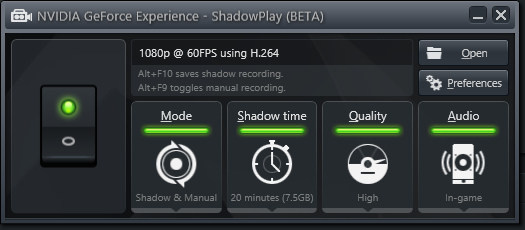
With regards to functionality, all of Shadowplay’s basic functionality is in. The utility offers two recording modes: a manual mode and a shadow mode, the former being self-explanatory while the latter being an always-active rolling buffer of up to 20 minutes that allows saving the buffer after the fact in a DVR-like fashion. Saving the shadow buffer causes the entirety of the buffer to be saved and a new buffer started, while manual mode can be started and stopped as desired.
| Shadowplay Average Bitrates | |||
| High Quality | 52Mbps | ||
| Medium Quality |
23Mbps
|
||
| Low Quality |
16Mbps
|
||
Next to being able to control the size of the shadow buffer, Shadowplay’s other piece of significant flexibility comes through the ability to set the quality (and therefore file size) of the recordings Shadowplay generates. Since Shadowplay uses lossy H.264 the recording bitrates will scale with the quality, with Shadowplay offering 3 quality levels: high (52Mbps), medium (23Mbps), and low (16Mbps). Choosing between the quality levels will depend on the quality needed and what the recording is intended for, due to the large difference in quality and size. High quality is as close as Shadowplay gets to transparent compression, and with its large file sizes is best suited for further processing/transcoding. Otherwise Medium and Low are low enough bitrates that they’re reasonably suitable for distribution as-is, however there is a distinct quality tradeoff in using these modes.
Moving on, at this moment while Shadowplay offers a range of quality settings for recording it only offers a single resolution and framerate: 1080p at 60fps. Neither the frame rate nor the resolution is currently adjustable, so whenever you record and despite the resolution you record from, it will be resized to 1920x1080 and recorded at 60fps. This unfortunately is an aspect-ratio unaware resize too, so even non-16:9 resolutions such as 1920x1200 or 2560x1600 will be resized to 1080p. Consequently at this time this is really the only weak point for Shadowplay; while the NVENC encoder undoubtedly presents some limitations, the inability to record at just a lower resolution or in an aspect ratio compliant manner is something we’d like to see NVIDIA expand upon in the final version of the utility.
Finally, let’s talk about performance. One of Shadowplay’s promises was that the overhead from recording would be very low – after all, it needs to be low enough to make always-on shadow mode viable – and this is another area where the product lives up to NVIDIA’s claims. To be sure there’s still some performance degradation from enabling Shadowplay, about 5% by our numbers, but this is small enough that it should be tolerable. Furthermore Shadowplay doesn’t require capping the framerate like FRAPS does, so it’s possible to use Shadowplay and still maintain framerates over 60fps. Though as to be expected, this will introduce some frame skipping in the captured video, since Shadowplay will have to skip some frames to keep within its framerate limitations.
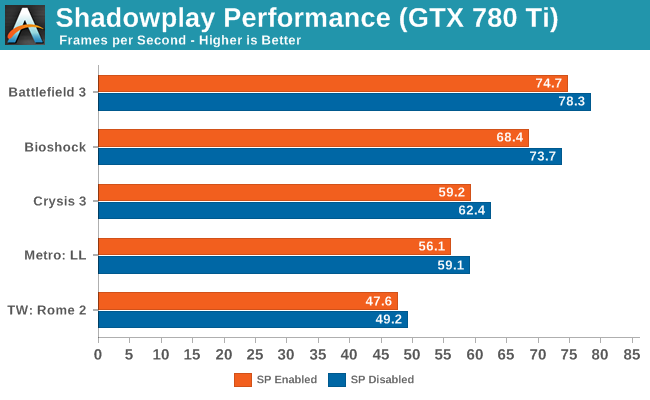
On a related note, we did some digging for a technical answer for why Shadowplay performs as well as it does, and found our answer in an excellent summary of Shadowplay by Alexey Nicolaychuk, the author of RivaTuner and its derivatives (MSI Afterburner and EVGA Precision). As it turns out, although the NVENC video encoder plays a part in that – compressing the resulting video and making the resulting stream much easier to send back to the host and store – that’s only part of the story. The rest of Shadowplay’s low overhead comes from the fact that NVIDIA also has specific hardware and API support for the fast capture of frames built into Kepler GPUs. This functionality was originally intended to facilitate GRID and game streaming, which can also be utilized for game recording (after all, what is game recording but game streaming to a file instead of another client?).
This functionality is exposed as Frame Buffer Capture (NVFBC) and Inband Frame Readback (NVIFR). NVFBC allows Shadowplay to pull finished frames straight out of the frame buffer directly at a low level, as opposed to having to traverse the graphics APIs at a high level. Meanwhile NVIFR does have operate at a slightly higher level to inject itself into the graphics API, but in doing so it gains the flexibility to capture images from render targets as opposed to just frame buffers. Based on what we’re seeing we believe that NVIDIA is using NVFBC for Shadowplay, which would be the lowest overhead option while also explaining why Shadowplay can only capture full screen games and not windowed mode games, as frame buffer capturing is only viable when a game has exclusive control over the frame buffer.
Wrapping things up, it’s clear that NVIDIA still has some polishing they can apply to Shadowplay, and while they aren’t talking about the final release this soon, as a point of reference it took about 4 months for NVIDIA’s SHIELD game streaming component to go from beta to a formal, finished release. In the interim however it’s already in a very usable state, and it should be worth keeping an eye on in the future to see what else NVIDIA does to further improve the utility.
The Test
The press drivers for the launch of the GTX 780 Ti are release 331.70, which other than formally adding support for the new card is otherwise identical to the standing 331.65 drivers.
Meanwhile on a housekeeping note, we want to quickly point out that we’ll be deviating a bit from our normal protocol and including the 290X results for both normal (quiet) and uber modes. Typically we’d only include results from the default mode in articles such as these, but since we need to cover SLI/Crossfire performance and since we didn’t have 290X CF quiet mode results for our initial 290X review, we’re throwing in both so that we can compare the GTX 780 Ti to the 290X CF without being inconsistent by suddenly switching to the lower performance quiet mode numbers. Though with that said, for the purposes of our evaluation we will be focusing almost entirely on the quiet mode numbers, given the vast difference in both performance and noise that comes from using it.
| CPU: | Intel Core i7-4960X @ 4.2GHz |
| Motherboard: | ASRock Fatal1ty X79 Professional |
| Power Supply: | Corsair AX1200i |
| Hard Disk: | Samsung SSD 840 EVO (750GB) |
| Memory: | G.Skill RipjawZ DDR3-1866 4 x 8GB (9-10-9-26) |
| Case: | NZXT Phantom 630 Windowed Edition |
| Monitor: | Asus PQ321 |
| Video Cards: |
AMD Radeon R9 290X AMD Radeon R9 290 XFX Radeon R9 280X Double Dissipation AMD Radeon HD 7990 AMD Radeon HD 7970 NVIDIA GeForce GTX Titan NVIDIA GeForce GTX 780 Ti NVIDIA GeForce GTX 780 NVIDIA GeForce GTX 770 |
| Video Drivers: |
NVIDIA Release 331.58 WHQL NVIDIA Release 331.70 Beta AMD Catalyst 13.11 Beta v1 AMD Catalyst 13.11 Beta v5 AMD Catalyst 13.11 Beta v8 |
| OS: | Windows 8.1 Pro |
Metro: Last Light
As always, kicking off our look at performance is 4A Games’ latest entry in their Metro series of subterranean shooters, Metro: Last Light. The original Metro: 2033 was a graphically punishing game for its time and Metro: Last Light is in its own right too. On the other hand it scales well with resolution and quality settings, so it’s still playable on lower end hardware.
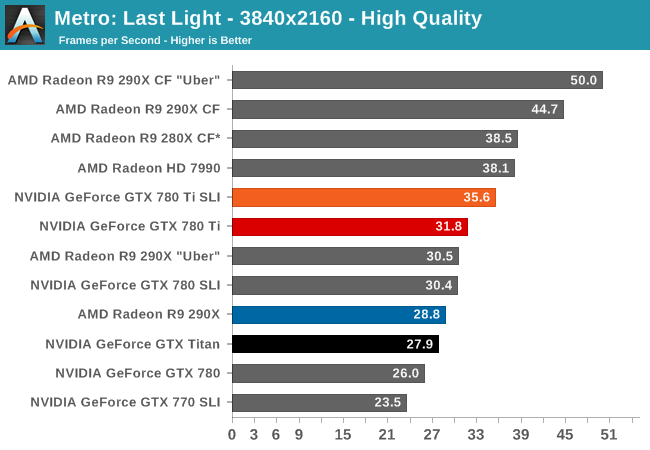
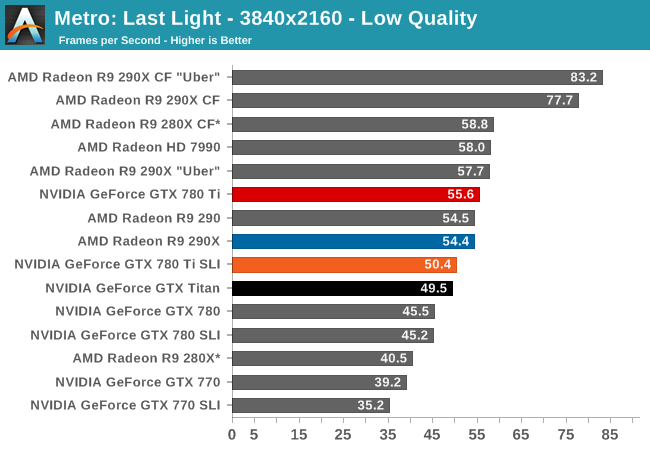
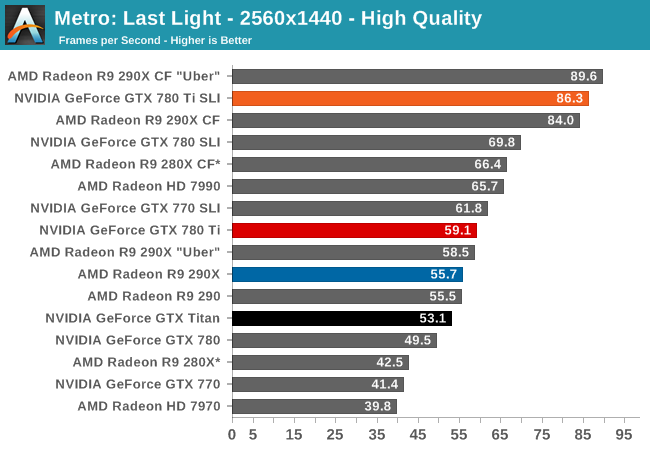
For the bulk of our analysis we’re going to be focusing on our 2560x1440 results, as monitors at this resolution will be what we expect a single GTX 780 Ti to be primarily used with. A single card does have the necessary horsepower to drive a 4K monitor on its own, but only at lower quality settings. Even as powerful as GTX 780 Ti is, a pair of them will be needed to get good framerates out of most games if using 4K at high quality settings.
Looking at our Metro: Last Light results then, it’s the start of what’s going to be a fairly consistent streak for the GTX 780 Ti. Though it doesn’t improve on GTX Titan or GTX 780’s gaming performance by leaps and bounds, the additional SMX and increased clockspeeds means that it has little trouble pulling away from those cards and from AMD’s 290 series. As a result the GTX 780 Ti beats the GTX Titan by 11%, GTX 780 by 19%, and though it’s closer than normal, the lead over the 290X stands at 6%.
To that end in Metro it leads the pack of single-GPU cards, though it does come up just short of being able to average 60 frames per second at 2560. Anything over 60fps will require multiple GPUs; and even then GTX 780 Ti is fast enough that sometimes even a pair of GPUs (GTX 770 SLI) isn’t going to be appreciably faster.
Meanwhile looking at GTX 780 Ti SLI performance, the SLI setup tops the charts at 2560 for everything short of the 290X in uber mode, though in this case (like most cases) two high-end GPUs is on the verge of being overkill even at 2560. Otherwise looking at 4K, NVIDIA’s poor 4K scaling on Metro once again makes itself present here, with NVIDIA’s performance only minimally benefitting from the second card. In the case of Metro at 4K, the 290X CF is going to be by far the faster option.
Company of Heroes 2
Our second benchmark in our benchmark suite is Relic Games’ Company of Heroes 2, the developer’s World War II Eastern Front themed RTS. For Company of Heroes 2 Relic was kind enough to put together a very strenuous built-in benchmark that was captured from one of the most demanding, snow-bound maps in the game, giving us a great look at CoH2’s performance at its worst. Consequently if a card can do well here then it should have no trouble throughout the rest of the game.
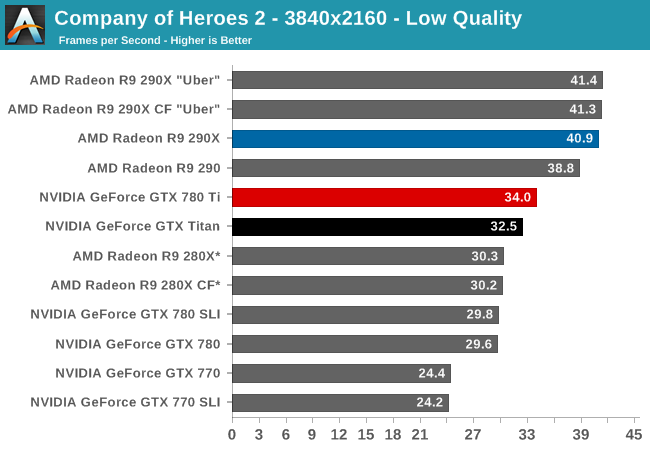
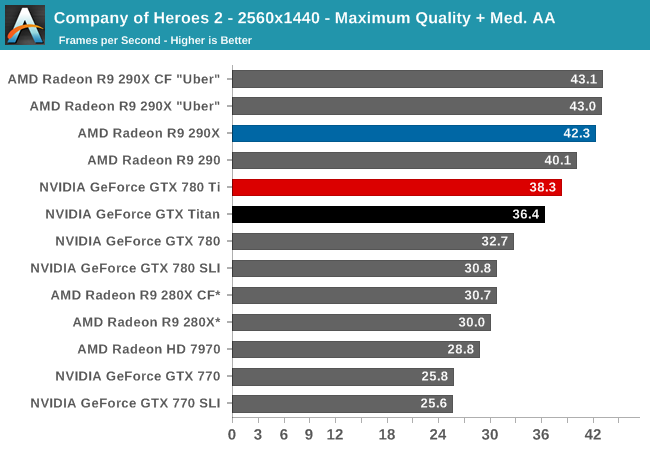
Since Company of Heroes 2 is not an AFR friendly game, getting the best performance out of the game requires having the fastest GPU. While the GTX 780 Ti has a clear lead over the 290X across the average of our games, in this specific case it’s going to come up short, as AMD’s performance with this game is simply too high to be overcome without a significant performance advantage. Conversely this means that GTX 780 Ti and 290X are still close enough that NVIDIA won’t be able to sweep every game; in games where AMD still does exceptionally well, they’ll be able to close the gap and surpass the GTX 780 Ti.
Meanwhile, looking at a straight-up NVIDIA comparison, the GTX 780 Ti holds a slightly smaller than normal lead over its counterparts. At 5% faster than GTX Titan and 17% faster than GTX 780 it’s still the fastest of the cards, but it won’t pull ahead in this game by as much as it does elsewhere.
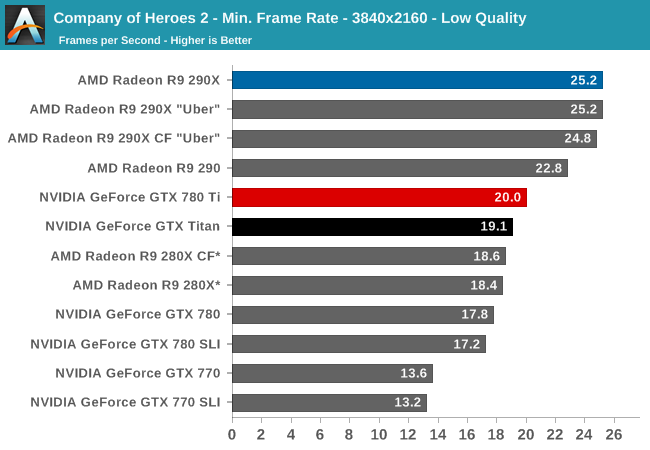
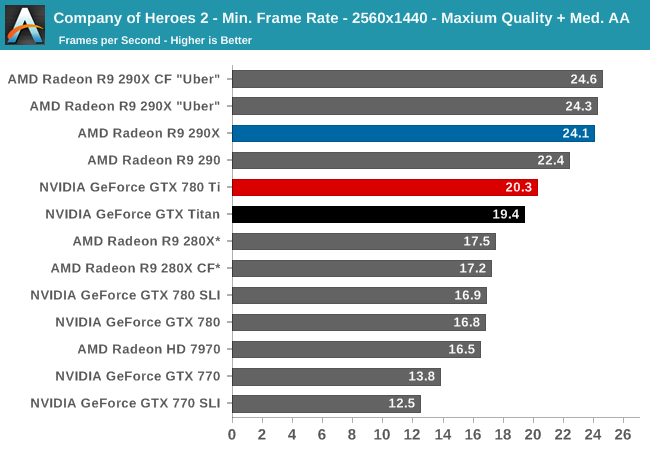
The minimum framerate story is largely the same. GTX 780 Ti is the fastest NVIDIA card, but it will trail the 290X by over 10% in both scenarios.
Bioshock Infinite
Bioshock Infinite is Irrational Games’ latest entry in the Bioshock franchise. Though it’s based on Unreal Engine 3 – making it our obligatory UE3 game – Irrational had added a number of effects that make the game rather GPU-intensive on its highest settings. As an added bonus it includes a built-in benchmark composed of several scenes, a rarity for UE3 engine games, so we can easily get a good representation of what Bioshock’s performance is like.
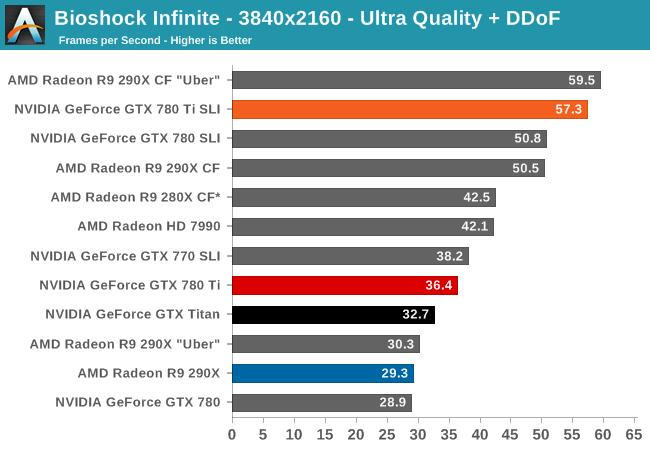
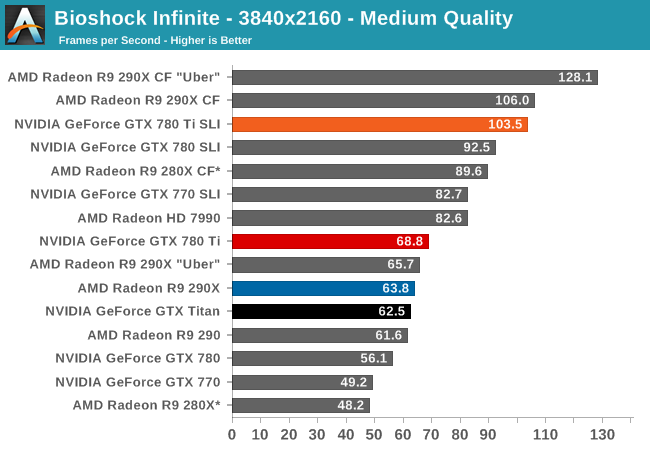
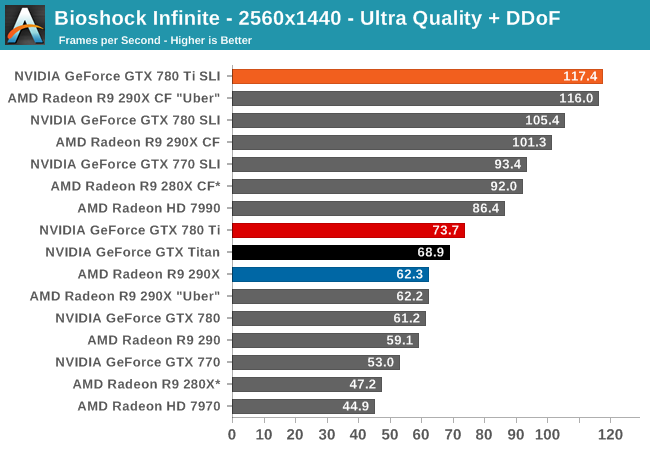
As opposed to our previous game, with Bioshock the GTX 780 Ti comes out at a very strong contender, easily surpassing everything AMD and NVIDIA. Here we see it best AMD’s best by 18%, and against GTX Titan and GTX 780 it’s 7% and 20% ahead respectively. Though admittedly everything here is averaging better than 60fps at this point.
Meanwhile for the AFR matchup, with a pair of GTX 780 Ti’s we’re either looking framerates that will make a 120Hz gamer happy, or enough horsepower to take on 4K at our highest settings and still come out well ahead. At 57.3fps the GTX 780 Ti is several frames per second ahead of the 290X CF, coming up just short of averaging 60fps even at this very high resolution.
Battlefield 3
Our major multiplayer action game of our benchmark suite is Battlefield 3, DICE’s 2011 multiplayer military shooter. Its ability to pose a significant challenge to GPUs has been dulled some by time and drivers, but it’s still a challenge if you want to hit the highest settings at the highest resolutions at the highest anti-aliasing levels. Furthermore while we can crack 60fps in single player mode, our rule of thumb here is that multiplayer framerates will dip to half our single player framerates, so hitting high framerates here may not be high enough.
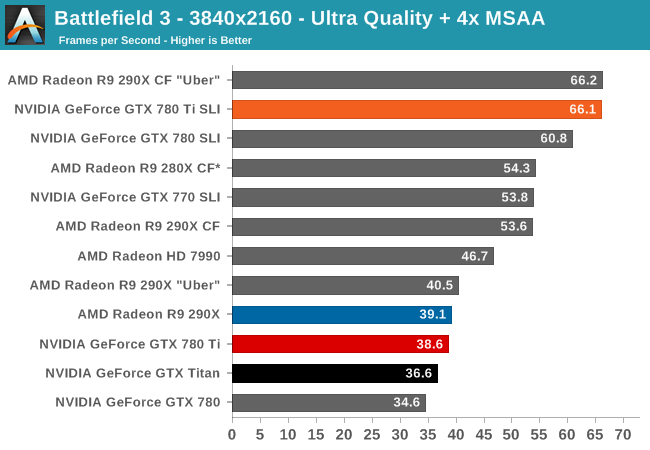
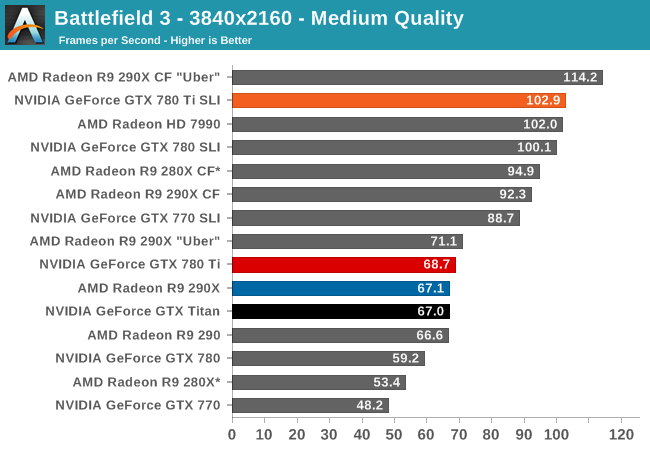
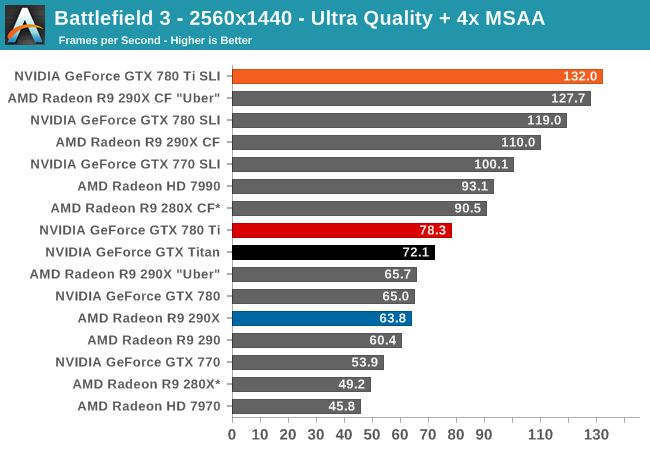
BF3 is another strong title for NVIDIA and the GTX 780 Ti. The performance advantage for the GTX 780 Ti over its GK110 siblings stands at a rather typical 9% for GTX Titan and 20% for GTX 780, with an absolute framerate well above 60fps and ultimately approaching 80fps. Otherwise against the 290X this is consistently one of the best games for NVIDIA, so it comes as no surprise that the GTX 780 Ti does very well against the 290X here, beating it by a substantial 23%.
Moving on to SLI performance, the GTX 780 SLI is once again a chart topper. Even 3840x2160 and with Ultra quality, the GTX 780 Ti still more than enough to deliver more than 60fps, making this a fully playable resolution with minimum framerates that should easily be over 30fps.
Crysis 3
Still one of our most punishing benchmarks, Crysis 3 needs no introduction. With Crysis 3, Crytek has gone back to trying to kill computers and still holds “most punishing shooter” title in our benchmark suite. Only in a handful of setups can we even run Crysis 3 at its highest (Very High) settings, and that’s still without AA. Crysis 1 was an excellent template for the kind of performance required to drive games for the next few years, and Crysis 3 looks to be much the same for 2013.
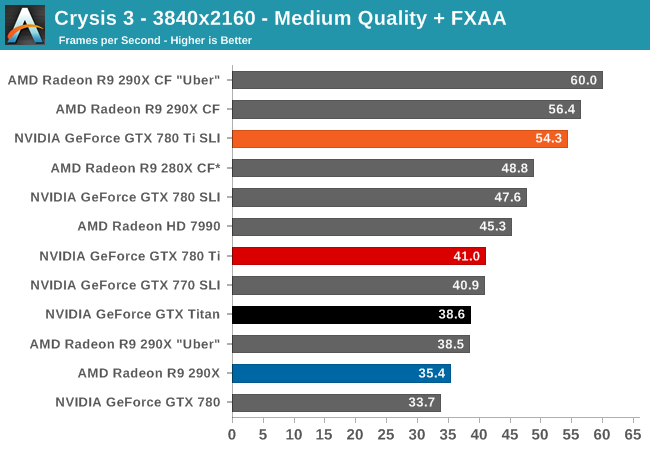
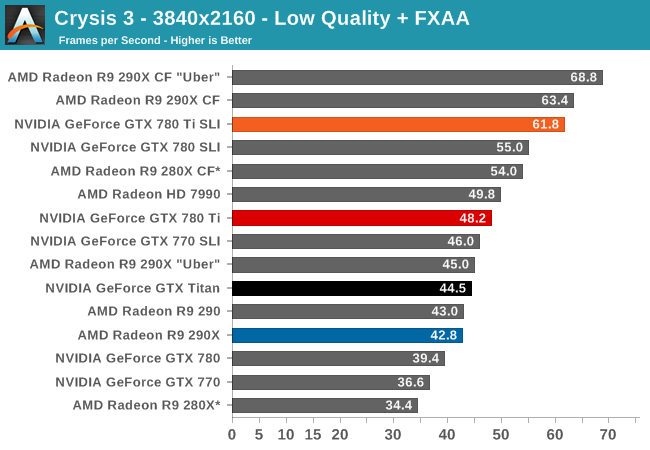
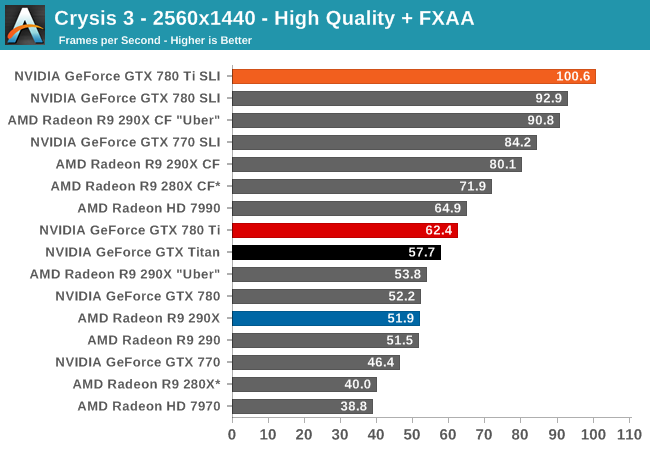
Crysis 3 is another strong title for NVIDIA, leading to GTX 780 Ti easily taking the top spot at 2560 for single-GPU setups. At 62.4fps it’s the first and only card fast enough to deliver better than 60fps despite Crysis 3’s punishing rendering workload, and in the process outperforms the 290X by about 20%. Even 7990, the closest thing to single-card competition for the GTX 780 Ti, is still only less than 2fps ahead.
Meanwhile throwing on another GTX 780 Ti will further improve performance here, though with shaky results for NVIDIA. At 2560 this is enough to crack 100fps, but at a 4K NVIDIA’s SLI scaling starts coming up short. The difference in scaling becomes so great that the 290X closes the gap and then some, leading to the 290X CF taking the lead. Given the fact that the GTX 780 Ti SLI is largely overkill for anything but these high resolutions, this weaker scaling undercuts the practicality of going with a GTX 780’s Ti SLI in these situations.
Crysis: Warhead
Up next is our legacy title for 2013/2014, Crysis: Warhead. The stand-alone expansion to 2007’s Crysis, at over 5 years old Crysis: Warhead can still beat most systems down. Crysis was intended to be future-looking as far as performance and visual quality goes, and it has clearly achieved that. We’ve only finally reached the point where single-GPU cards have come out that can hit 60fps at 1920 with 4xAA, never mind 2560 and beyond.
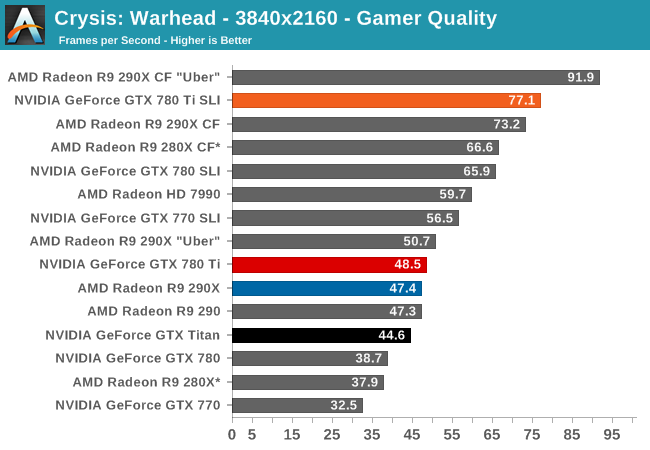
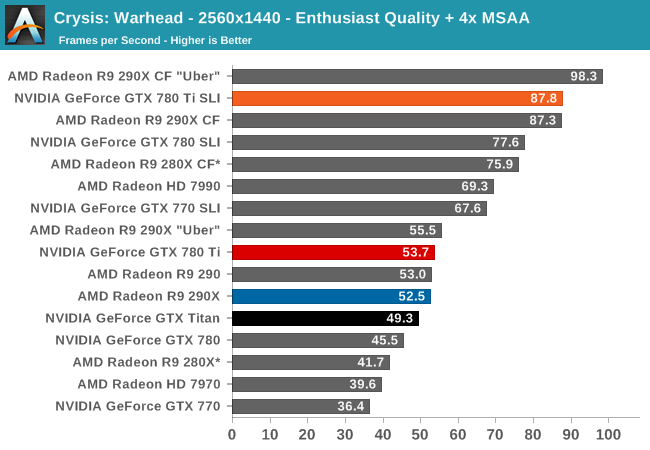
Whereas Battlefield 3 is a game that traditionally favors NVIDIA, Crysis: Warhead has generally favored AMD in this generation, leading to an uphill battle for NVIDIA. 290X was able to beat GTX Titan here at 2560, but with the additional performance offered by the GTX 780 Ti NVIDIA is once again at the top, though only by a margin of under 2fps (or 2%). Otherwise compared to NVIDIA’s other cards, Crysis: Warhead is another consistent game for GTX 780 Ti, with NVIDIA’s latest card beating GTX Titan and GTX 780 by 9% and 18% respectively.
Moving on, even when we double up on cards the GTX 780 Ti and 290X remain close. At 2560 it’s a virtual tie at 87fps apiece, while at 4K the GTX 780 Ti SLI takes a slight lead.
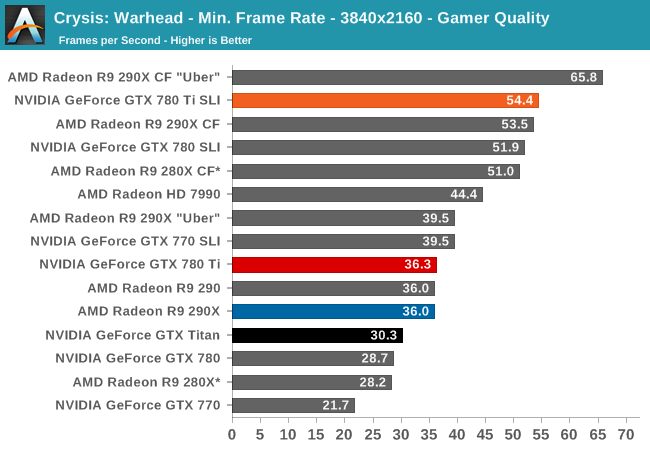
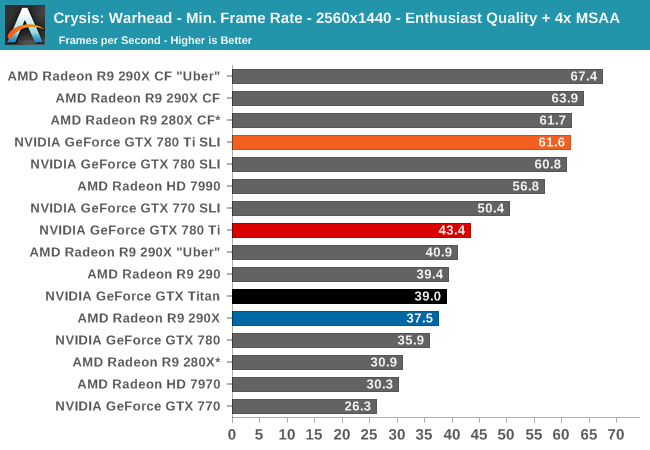
As for our minimum framerates under Crysis: Warhead, NVIDIA does end up breaking the deadlock here with a slight performance advantage for the GTX 780 Ti, beating the 290X by several percent, pushing its minimum framerate above 40fps.
Total War: Rome 2
The second strategy game in our benchmark suite, Total War: Rome 2 is the latest game in the Total War franchise. Total War games have traditionally been a mix of CPU and GPU bottlenecks, so it takes a good system on both ends of the equation to do well here. In this case the game comes with a built-in benchmark that plays out over a forested area with a large number of units, definitely stressing the GPU in particular.
For this game in particular we’ve also gone and turned down the shadows to medium. Rome’s shadows are extremely CPU intensive (as opposed to GPU intensive), so this keeps us from CPU bottlenecking nearly as easily.


Total War: Rome 2 is another AFR-unfriendly game, and consequently a game where the fastest single-GPU setup is going to be the fastest setup overall. To that end the GTX 780 Ti once again wins at 2560, beating the 290X by 17% and coming up a fraction of a frame short of averaging 50fps. In this case Rome has something of an appetite for memory bandwidth, playing well into the GTX 780 Ti’s design due to the upgrade to 7GHz GDDR5. Consequently the GTX 780 also takes a larger than normal lead over the GTX Titan and GTX 780, beating the two cards by 11% and 24% respectively.
Hitman: Absolution
The second-to-last game in our lineup is Hitman: Absolution. The latest game in Square Enix’s stealth-action series, Hitman: Absolution is a DirectX 11 based title that though a bit heavy on the CPU, can give most GPUs a run for their money. Furthermore it has a built-in benchmark, which gives it a level of standardization that fewer and fewer benchmarks possess.
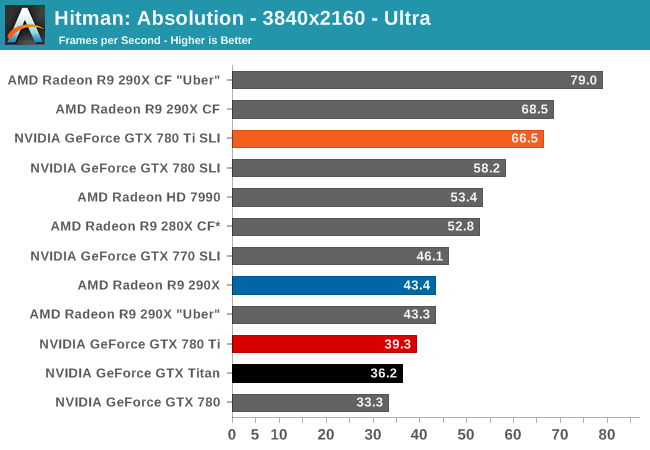
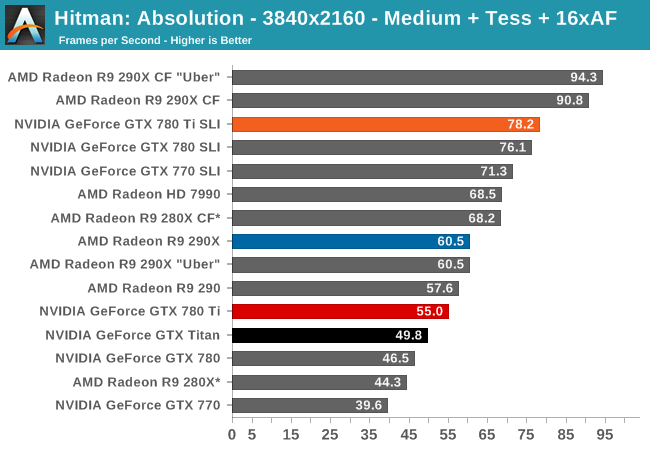
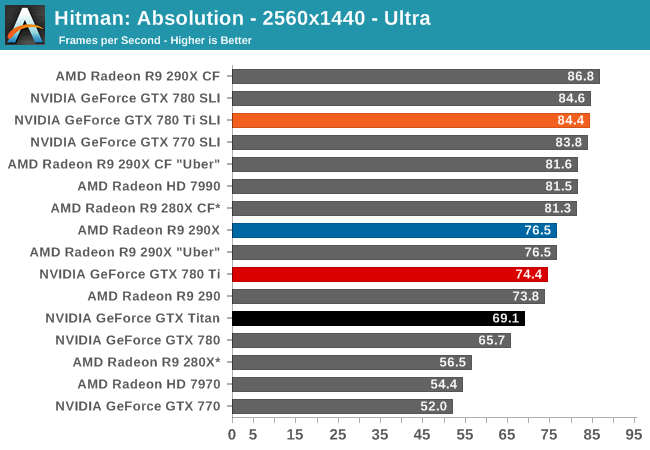
On a competitive basis Hitman: Absolution ends up being the second and last title where the GTX 780 Ti just doesn’t have enough performance to overcome AMD’s lead. Compared to where we were 2 weeks ago the GTX 780 Ti significantly cuts into the 290X’s lead, but in the end it’ll come up 3% behind. Though as with Bioshock we’re admittedly looking at another scenario where everyone is already past 60fps, so the absolute performance difference is somewhat academic.
As for our multi-GPU setups at 4K the story is much the same. Both 290X CF and GTX 780 Ti SLI get above 60fps, but it’s 290X CF that takes the top spot.
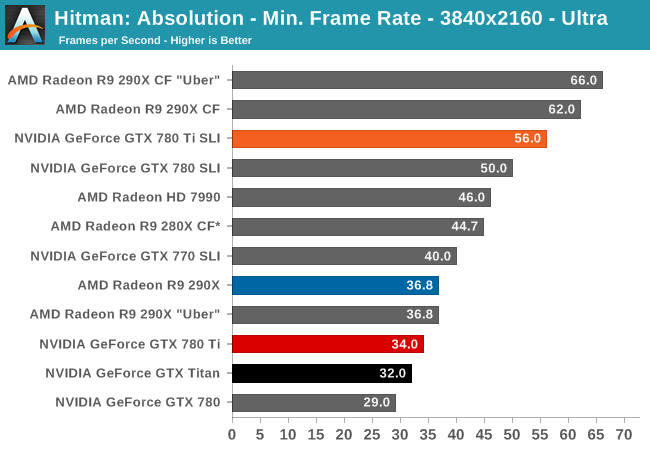
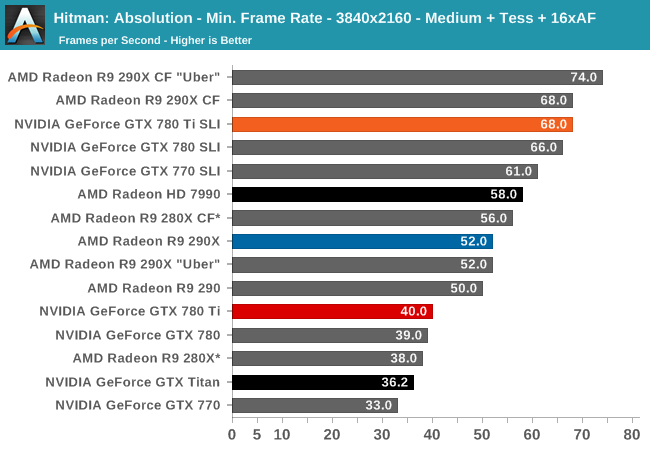
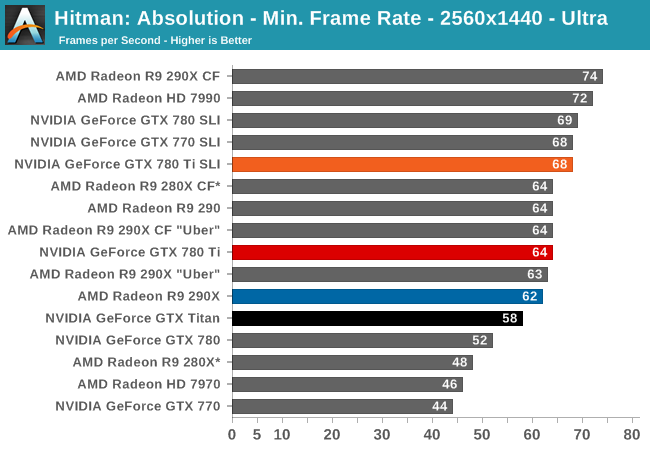
Looking briefly at our minimum framerates, as we’re approaching a CPU limited scenario we have a mix of results. Despite losing on averages, the GTX 780 Ti wins on minimums by 2fps, bottoming out at 64fps and making it the first GK110 card to offer a minimum over 60fps. On the other hand if we scale up to 4K and multi-GPU setups, the GTX 780 Ti SLI will clearly come up short versus the 290X CF, with the latter being the only setup to break 60fps there.
GRID 2
The final game in our benchmark suite is also our racing entry, Codemasters’ GRID 2. Codemasters continues to set the bar for graphical fidelity in racing games, and with GRID 2 they’ve gone back to racing on the pavement, bringing to life cities and highways alike. Based on their in-house EGO engine, GRID 2 includes a DirectCompute based advanced lighting system in its highest quality settings, which incurs a significant performance penalty but does a good job of emulating more realistic lighting within the game world.
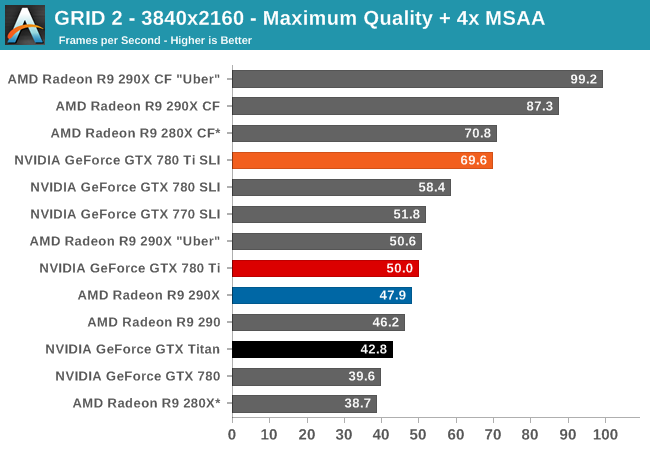
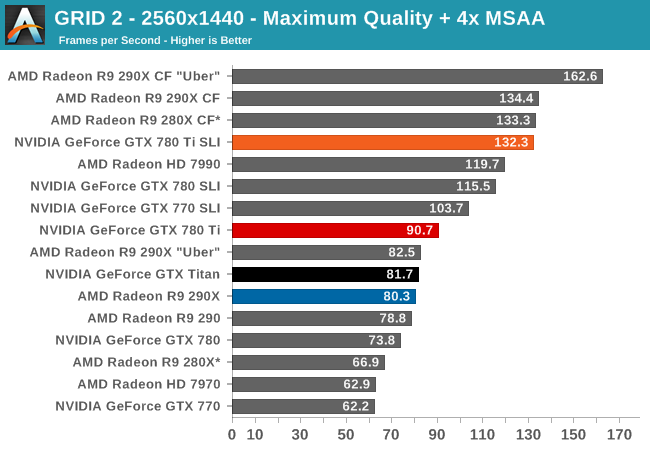
When it comes to GRID even cranking up the game’s quality settings to maximum hardly does anything to slow down our cards. At 90fps the GTX 780 Ti once again takes the top spot while delivering an extremely high framerate. This ultimately puts the GTX 780 Ti ahead of the 290X by 13%, while also beating the other GK110 cards by a bit more than average at 11% for GTX Titan and 23% for GTX 780.
Otherwise, moving on to 4K and multi-GPU setups, NVIDIA’s limited scaling once more becomes an issue. At 50fps for a single GTX 780 Ti NVIDIA starts off well enough, but we still need a second GPU to get above 60fps. And though GTX 780 Ti SLI will get us there, 290X CF and AMD’s superior scaling will get AMD there with room to spare.
Synthetics
As always we’ll also take a quick look at synthetic performance, though as GTX 780 is just another GK110 card, there shouldn't be any surprises here.
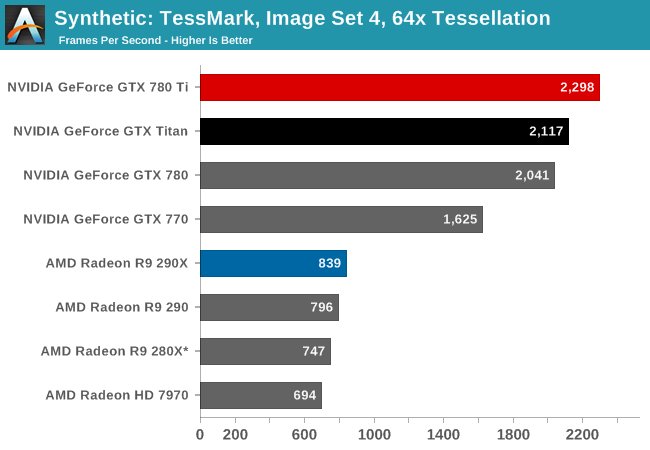
As expected, firing up the 15th SMX and slightly increasing their clockspeed has further cemented NVIDIA’s hold on tessellation performnace.
Moving on, we have our 3DMark Vantage texture and pixel fillrate tests, which present our cards with massive amounts of texturing and color blending work. These aren’t results we suggest comparing across different vendors, but they’re good for tracking improvements and changes within a single product family.
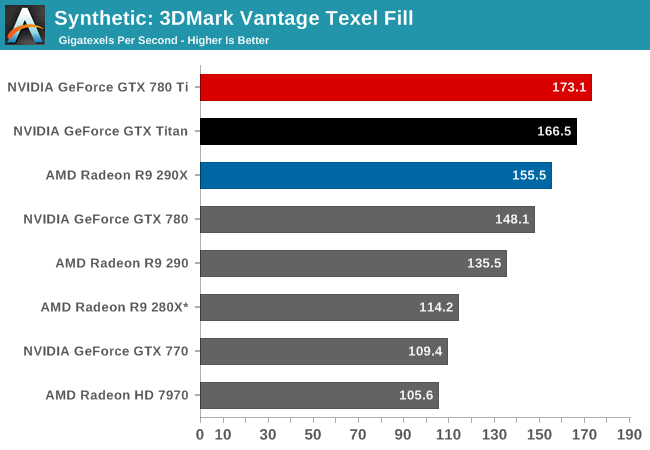
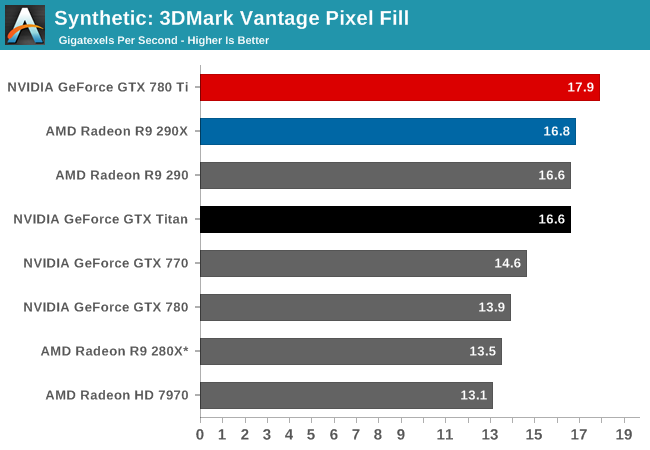
Similarly, both texel and pixel fillrates as seen by 3DMark Vantage have increased. For texel fillrates the biggest benefit is the 15th SMX, while the pixel fillrates benefit from a mix of the higher GPU clockspeed and the increased memory bandwidth, further improving the peak performance of NVIDIA’s render backend.
Compute
Jumping into compute, we’re entering the one area where GTX 780 Ti’s rule won’t be nearly as absolute. Among NVIDIA cards its single precision performance will be unchallenged, but the artificial double precision performance limitation as compared to the compute-focused GTX Titan means that GTX 780 Ti will still lose to GTX Titan whenever double precision comes into play. Alternatively, GTX 780 Ti still has to deal with the fact that AMD’s cards have shown themselves to be far more competitive in our selection of compute benchmarks.
As always we'll start with our DirectCompute game example, Civilization V, which uses DirectCompute to decompress textures on the fly. Civ V includes a sub-benchmark that exclusively tests the speed of their texture decompression algorithm by repeatedly decompressing the textures required for one of the game’s leader scenes. While DirectCompute is used in many games, this is one of the only games with a benchmark that can isolate the use of DirectCompute and its resulting performance.
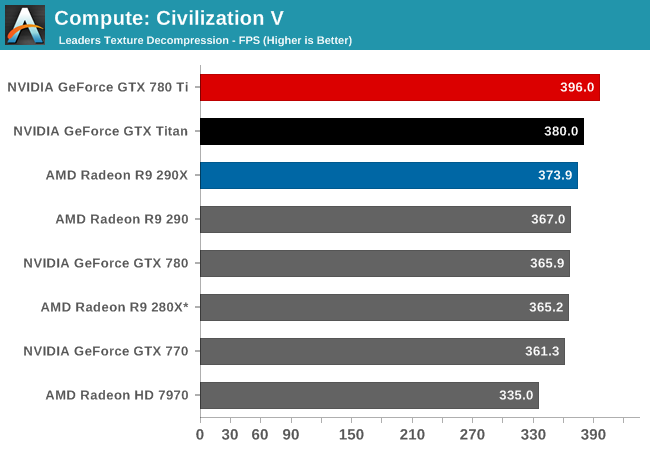
Even though we’re largely CPU bound by this point, GTX 780 Ti manages to get a bit more out of Civilization V’s texture decode routine, pushing it to the top of the charts and ahead of both GTX Titan and 290X.
Our next benchmark is LuxMark2.0, the official benchmark of SmallLuxGPU 2.0. SmallLuxGPU is an OpenCL accelerated ray tracer that is part of the larger LuxRender suite. Ray tracing has become a stronghold for GPUs in recent years as ray tracing maps well to GPU pipelines, allowing artists to render scenes much more quickly than with CPUs alone.
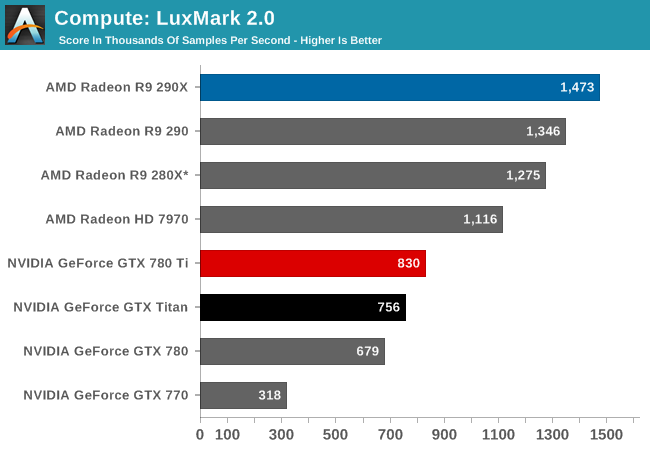
With LuxMark NVIDIA’s ray tracing performance sees further improvements due to the additional compute resources at hand. But NVIDIA still doesn’t fare well here, with the GTX 780 Ti falling behind all of our AMD cards in this test.
Our 3rd compute benchmark is Sony Vegas Pro 12, an OpenGL and OpenCL video editing and authoring package. Vegas can use GPUs in a few different ways, the primary uses being to accelerate the video effects and compositing process itself, and in the video encoding step. With video encoding being increasingly offloaded to dedicated DSPs these days we’re focusing on the editing and compositing process, rendering to a low CPU overhead format (XDCAM EX). This specific test comes from Sony, and measures how long it takes to render a video.
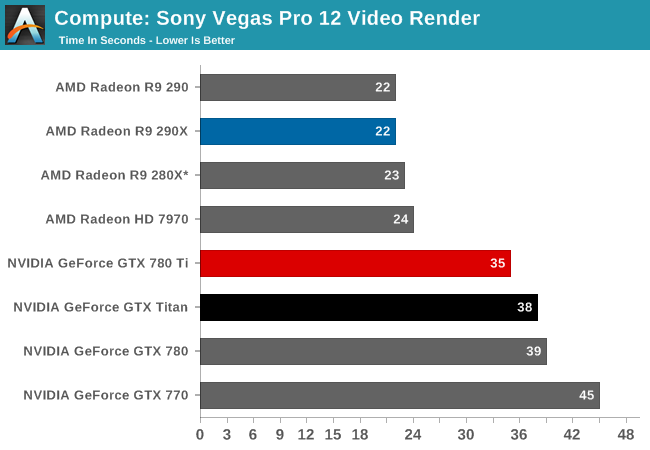
Like LuxMark, GTX 780 Ti once again improves on its predecessors. But it’s not enough to make up for AMD’s innate performance advantage in this benchmark, leading to GTX 780 Ti trailing all of the AMD cards.
Our 4th benchmark set comes from CLBenchmark 1.1. CLBenchmark contains a number of subtests; we’re focusing on the most practical of them, the computer vision test and the fluid simulation test. The former being a useful proxy for computer imaging tasks where systems are required to parse images and identify features (e.g. humans), while fluid simulations are common in professional graphics work and games alike.
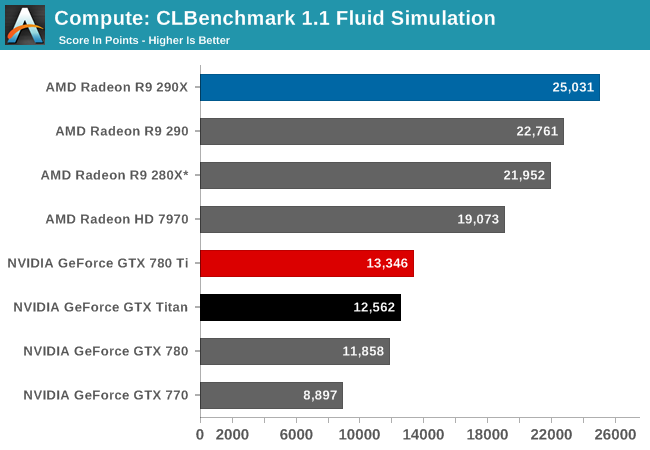
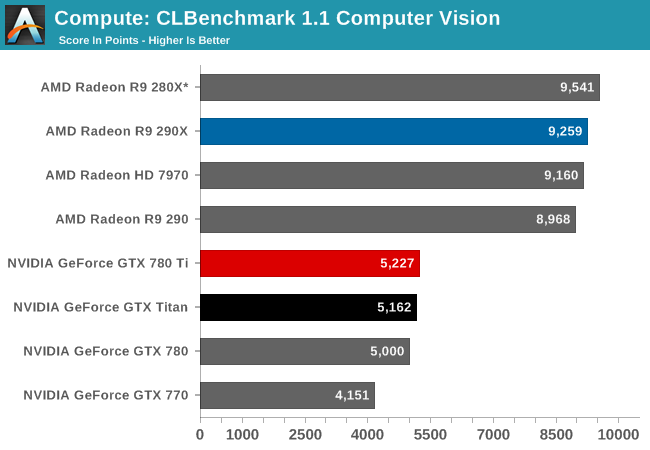
CLBenchmark continues to be the same story. GTX 780 Ti improves on NVIDIA’s performance to become their fastest single precision card, but it still falls short of every AMD card in these tests.
Moving on, our 5th compute benchmark is FAHBench, the official Folding @ Home benchmark. Folding @ Home is the popular Stanford-backed research and distributed computing initiative that has work distributed to millions of volunteer computers over the internet, each of which is responsible for a tiny slice of a protein folding simulation. FAHBench can test both single precision and double precision floating point performance, with single precision being the most useful metric for most consumer cards due to their low double precision performance. Each precision has two modes, explicit and implicit, the difference being whether water atoms are included in the simulation, which adds quite a bit of work and overhead. This is another OpenCL test, as Folding @ Home has moved exclusively to OpenCL this year with FAHCore 17.
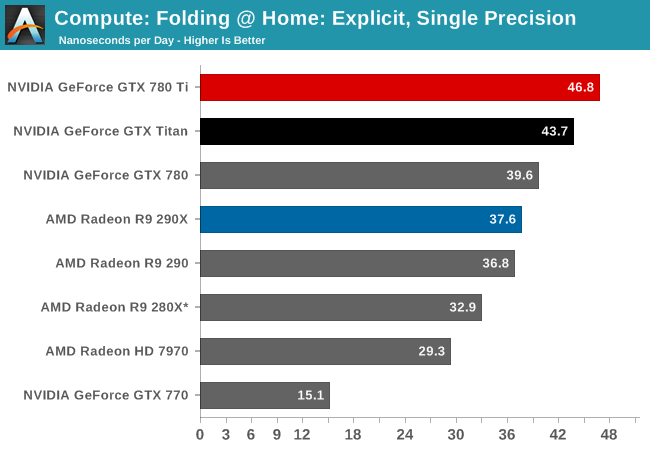
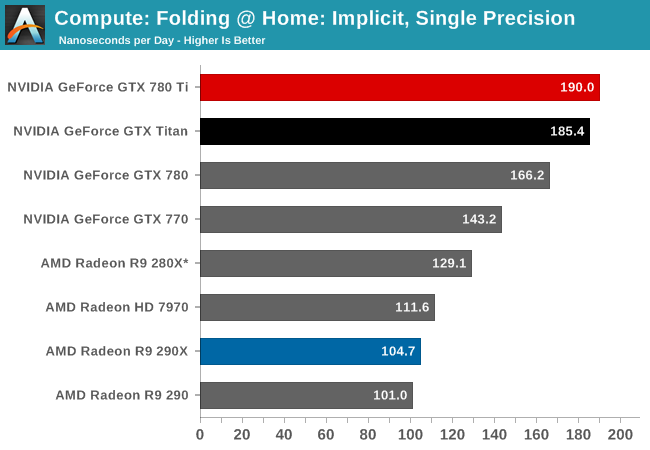
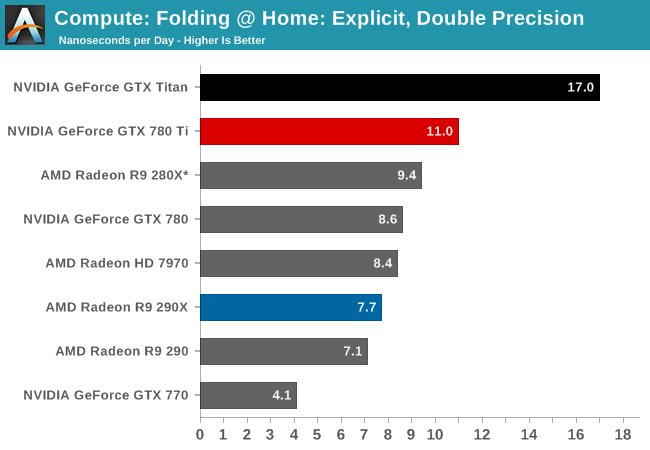
Finally with Folding@Home we see the GTX 780 Ti once again take the top spot. In the single precision tests the GTX 780 further extends NVIDIA’s lead, beating GTX Titan by anywhere between a few percent to over ten percent depending on which specific test we’re looking at. However even with GTX 780 Ti’s general performance increase, in the double precision test it won’t overcome the innate double precision performance deficit it faces versus GTX Titan. When it comes to double precision compute, Titan remains king.
Wrapping things up, our final compute benchmark is an in-house project developed by our very own Dr. Ian Cutress. SystemCompute is our first C++ AMP benchmark, utilizing Microsoft’s simple C++ extensions to allow the easy use of GPU computing in C++ programs. SystemCompute in turn is a collection of benchmarks for several different fundamental compute algorithms, as described in this previous article, with the final score represented in points. DirectCompute is the compute backend for C++ AMP on Windows, so this forms our other DirectCompute test.
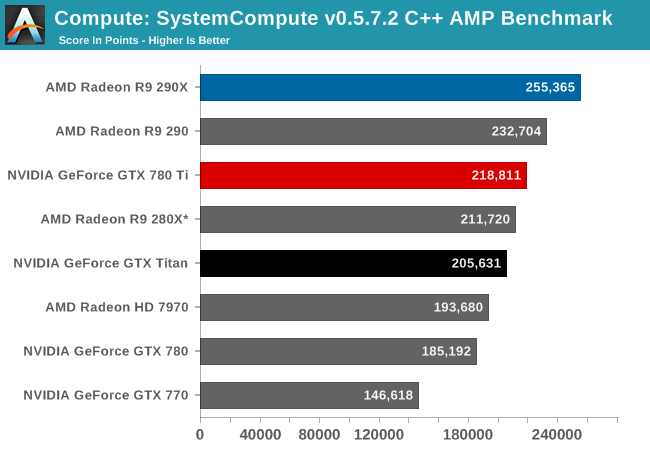
Last, in our C++ AMP benchmark we see the GTX 780 Ti take the top spot for an NVIDIA card, but like so many of our earlier compute tests it will come up short versus AMD’s best cards. This isn’t quite as lopsided as some of our other tests, however GTX 780 Ti is stuck competing with the 280X while the 290 and 290X easily outperform NVIDIA’s new flagship.
Power, Temperature, & Noise
As always, last but not least is our look at power, temperature, and noise. Next to price and performance of course, these are some of the most important aspects of a GPU, due in large part to the impact of noise. All things considered, a loud card is undesirable unless there’s a sufficiently good reason – or sufficiently good performance – to ignore the noise.
| GeForce GTX 780 Series Voltages | ||||
| GTX 780 Ti Boost Voltage | GTX 780 Boost Voltage | GTX 780 Ti Base Voltage | ||
| 1.187v | 1.1625v | 1.012v | ||
Taking a quick look at voltages, we find that our GTX 780 Ti operates at a slightly higher voltage at its maximum boost bin than the original GTX 780 did. The difference is minor, but the additional voltage may be necessary to hit the slightly higher clockspeeds GTX 780 Ti operates at relative to GTX Titan and GTX 780.
| GeForce GTX 780 Ti Average Clockspeeds | |||
| Max Boost Clock | 1020MHz | ||
| Metro: LL |
1000MHz
|
||
| CoH2 |
997MHz
|
||
| Bioshock |
954MHz
|
||
| Battlefield 3 |
980MHz
|
||
| Crysis 3 |
980MHz
|
||
| Crysis: Warhead |
1000MHz
|
||
| TW: Rome 2 |
950MHz
|
||
| Hitman |
993MHz
|
||
| GRID 2 |
967MHz
|
||
| Furmark |
823MHz
|
||
Moving on to clockspeeds, we find that the GTX 780 Ti does very well when it comes to boosting. With a maximum boost clock of 1020MHz, we have 2 benchmarks averaging 1000MHz, and another 4 averaging 980MHz or better.
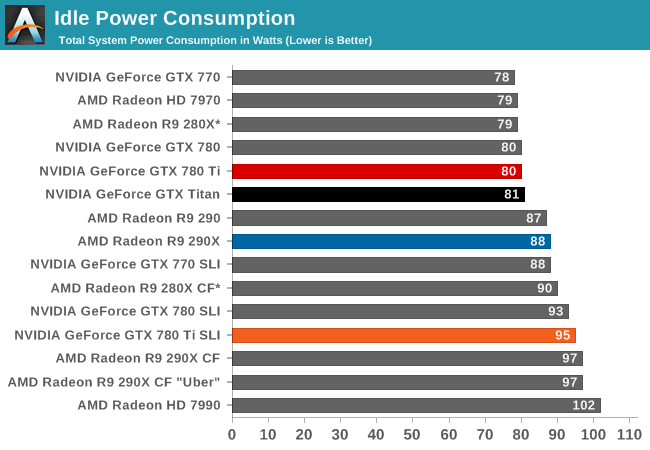
With all of our GK110 cards sharing a common design, at idle there’s very little to differentiate them. Other than GTX Titan’s extra 3GB of VRAM, we’re essentially looking at identical cards when idling.
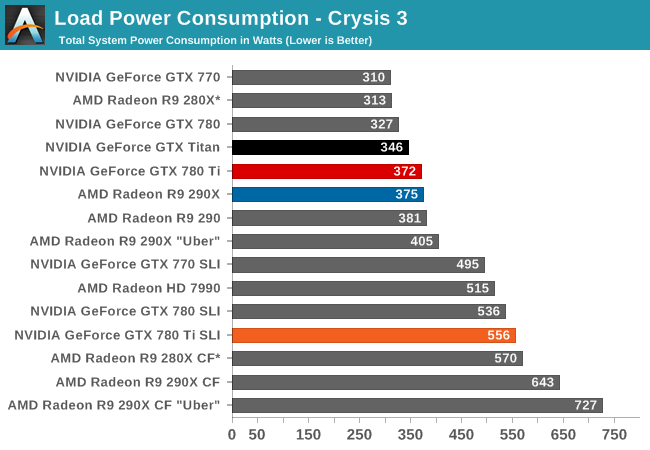
Moving on to load power, we can see the power/heat ramifications of the slight clockspeed increase coupled with the activation of the 15th SMX. Even with the further optimizations NVIDIA has put into the new revision of GK110, power consumption has gone up in accordance with the higher performance of the card, just as we’d expect. Since NVIDIA doesn’t notably alter their power efficiency here, that increased performance has to come at the cost of increased power consumption. Though in this benchmark it’s worth pointing out that we’re measuring from the wall and that GTX 780 Ti outperforms GTX Titan by 8%, so some of that 29W power difference will come from the higher CPU load caused by the increased framerates.
As for the GTX 780 Ti SLI, here we see power level off at 556W, 20W more than the GTX 780 SLI. Some (if not most) of that is going to be explained by the increased CPU power consumption from the GTX 780 Ti SLI’s higher framerates. Coupled with that is the fact that in SLI setups these cards get hotter, and hence have to downclock a bit more to maintain equilibrium, which helps to offset the increased power requirements of GTX 780 Ti and keep the SLI results so close to the GTX 780 SLI results.
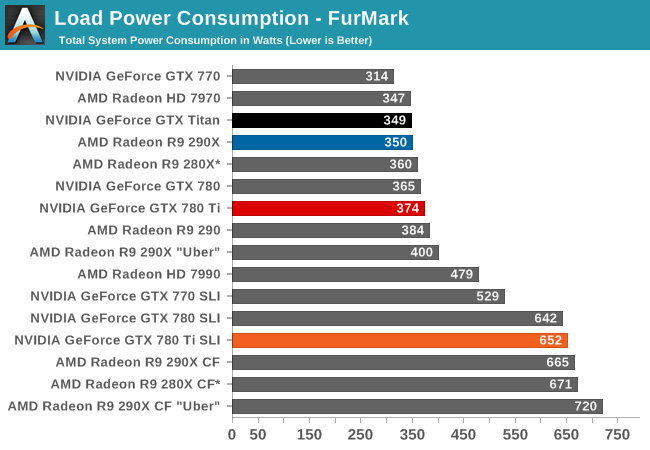
Switching over to FurMark, we find that power consumption is also up, but only slightly. With GPU Boost 2.0 clamping down on power consumption all of our GK110 cards should be clamped at 250W here, and with a difference between GTX 780 and GTX 780 Ti of under 10W, that’s exactly what appears to be happening here.
On a side note, it’s interesting to note here that under FurMark we’re seeing the GTX 780 Ti draw more power than the Radeon R9 290X. Despite the fact that the 290X has a higher rated TDP, in the card’s default quiet mode the card can’t actually dissipate as much heat (and thereby consume as much power) as the GTX 780 Ti can.
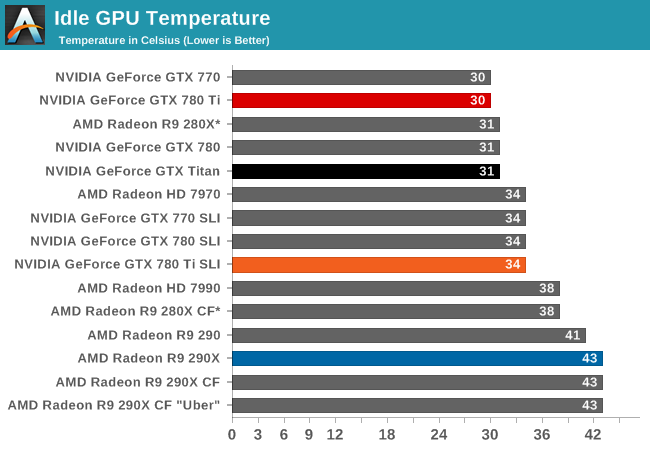
For idle temperatures we’re once again looking at cards that are for all intents and purposes identical. At 30C the GTX 780 Ti easily stays nice and cool.
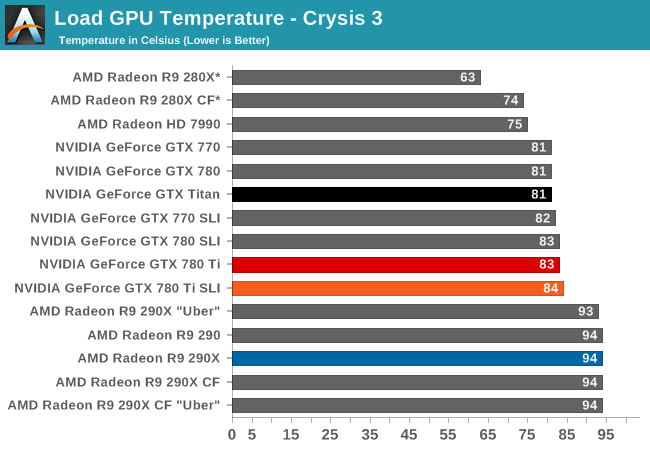
As we mentioned in our look at the GTX 780 Ti hardware, NVIDIA has increased their default temperature throttle point from 80C on the GTX Titan/780 to 83C on the GTX 780 Ti. The end result is that in all of our temperature limited tests the GTX 780 Ti will peak at 83C-84C, whereas the older GK110 cards will peak at 80C-81C.
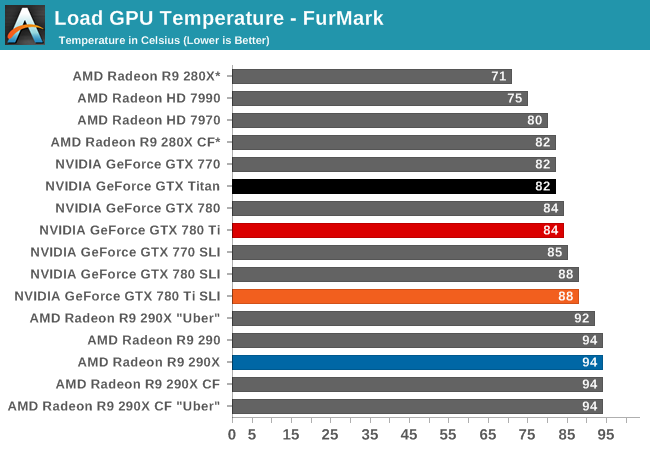
FurMark reiterates what we saw with Crysis 3. The temps are up a bit across the board, while the GK110 cards are holding near their throttle points. The SLI setups meanwhile approach the upper-80s at 88C, reflecting the fact that even with blowers, there’s some impact on neighboring cards in high load situations.
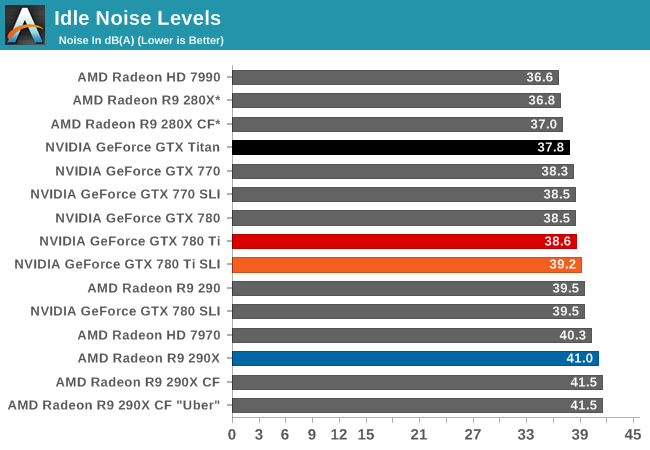
Our last idle scenario, we once again see all of our GK110 cards performing similarly, with idle noise levels in the 38dB-39dB range.
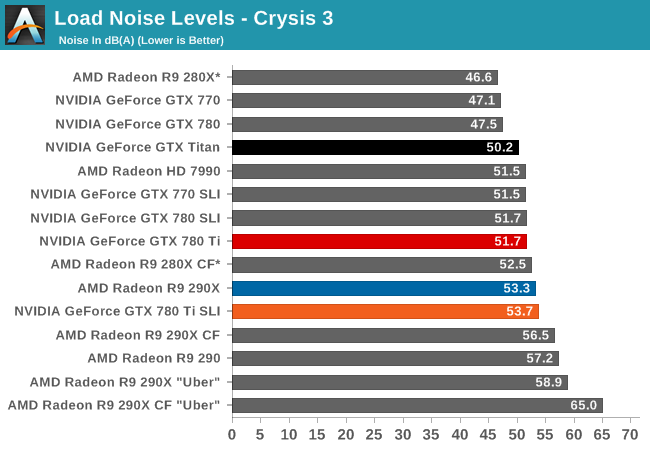
Moving on to our gaming load noise results, we can see the full repercussions of the GTX 780 Ti’s higher average power consumption coupled with the card’s higher temperature throttle point. Moving the throttle point along the same curve has the end result of moving higher the equilibrium point and thereby the card’s operating noise levels. As the fastest single-GPU card on this card, the GTX 780 Ti is still doing very well for itself and for a blower based design at 51.7dB, though at 1.5dB louder than GTX Titan and 4.2dB louder than GTX 780 the noise tradeoff for the card’s higher performance is very clear. Meanwhile the fact that it’s tied with the GTX 780 SLI comes with its own bit of irony.
Speaking of the GTX 780 SLI, we can see the noise impact of SLI configurations too. The GTX 780 Ti SLI levels out at 53.7dB, 2dB louder than our single-card configuration and 2dB louder than the GTX 780 SLI. At this point it’s just a bit louder than the 290X and quieter than a number of other 290 series setups.
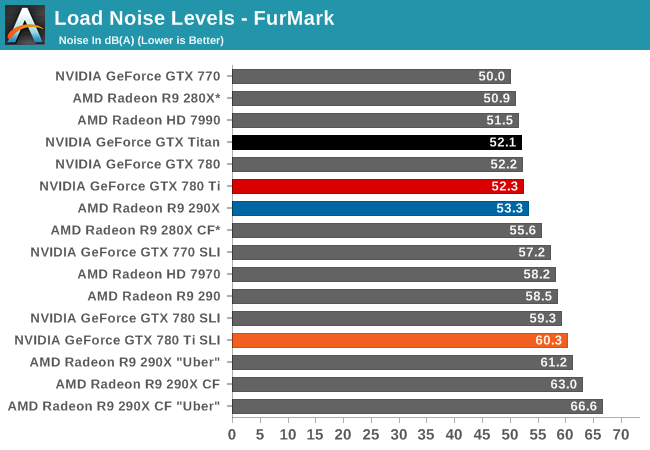
Finally with load noise levels under FurMark we can see where our various cards will peak at for noise levels. The GTX 780 Ti creeps up to 52.3dB, essentially tying with the GTX 780 and GTX Titan. Otherwise it comes in just behind the 290X, and the start of the pack for our multi-GPU setups.
As for the GTX 780 Ti SLI, like our single-card comparison points its up slightly as compared to the GTX 780 SLI.
Overall, our look at power, temperatures, and noise has been a rather straightforward validation of our earlier suspicions. GTX 780 Ti’s higher performance leads to higher power consumption, and will all other factors being held equal – including the cooler – power, temps, and noise levels all rise a bit as compared to GTX Titan and GTX 780. There’s no such thing as a free lunch here, and while GPU Boost 2.0 will keep the maximum levels suitably in check, on average GTX 780 Ti is going to be a bit worse than the other GK110 cards due to those factors. Though even with the increased noise levels in particular, GTX 780 Ti is still able to outperform 290X on noise while also delivering better gaming performance, which makes this another tidy victory for NVIDIA.
Overclocking
Finally, let’s spend a bit of time looking at the overclocking prospects for the GTX 780 Ti. Although GTX 780 Ti is now the fastest GK110 part, based on what we've seen with GTX 780 and GTX Titan there should still be some headroom to play with. Meanwhile there will also be the matter of memory overclocking, as 7GHz GDDR5 on a 384-bit bus presents us with a new baseline that we haven't seen before.
| GeForce GTX 780 Ti Overclocking | ||||
| Stock | Overclocked | |||
| Core Clock | 876MHz | 1026MHz | ||
| Boost Clock | 928MHz | 1078MHz | ||
| Max Boost Clock | 1020MHz | 1169MHz | ||
| Memory Clock | 7GHz | 7.6GHz | ||
| Max Voltage | 1.187v | 1.187v | ||
Overall our overclock for the GTX 780 Ti is a bit on the low side compared to the other GTX 780 cards we’ve seen in the past, but not immensely so. With a GPU overclock of 150MHz, we’re able to push the base clock and maximum boost clocks ahead by 17% and 14% respectively, which should further extend NVIDIA’s performance lead by a similar amount.
Meanwhile the inability to unlock a higher boost bin through overvolting is somewhat disappointing, as this is the first time we’ve seen this happen. To be clear here GTX 780 Ti does support overvolting – our card offers up to another 75mV of voltage – however on closer examination our card doesn’t have a higher bin within reach; 75mV isn’t enough to reach the next validated bin. Apparently this is something that can happen with the way NVIDIA bins their chips and implements overvolting, though this the first time we’ve seen a card actually suffer from this. The end result is that it limits our ability to boost at the highest bins, as we’d normally have a bin or two unlocked to further increase the maximum boost clock.
As for memory overclocking, we were able to squeeze out a bit more out of our 7GHz GDDR5, pushing our memory clock 600MHz (9%) higher to 7.6GHz. Memory overclocking is always something of a roll of the dice, so it’s not clear here whether this is average or not for a GK110 setup with 7GHz GDDR5. Given the general drawbacks of a wider memory bus we wouldn’t be surprised if this was average, but at the same time in practice GK110 cards haven’t shown themselves to be as memory bandwidth limited as GK104 cards. So 9%, though a smaller gain than what we’ve seen on other cards, should still provide GTX 780 Ti with enough to keep the overclocked GPU well fed.
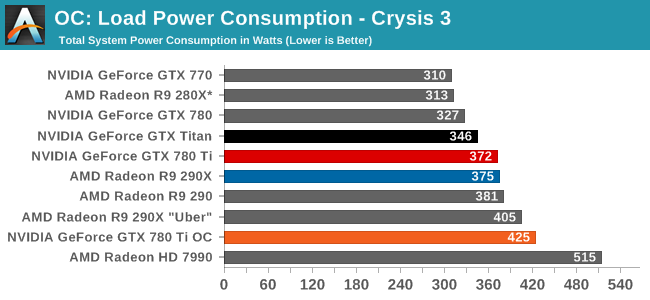
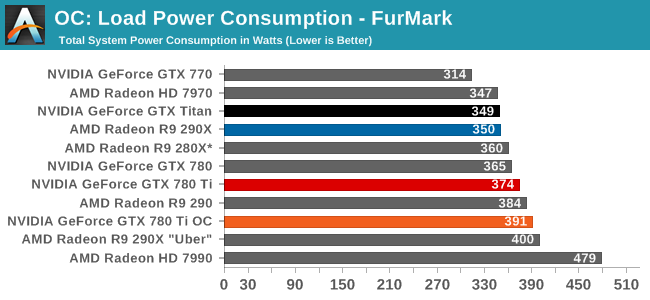
Starting as always with power, temperatures, and noise, we can see that overclocking GTX 780 Ti further increases its power consumption, and to roughly the same degree as what we’ve seen with GTX 780 and GTX Titan in the past. With a maximum TDP of just 106% (265W) the change isn’t so much that the card’s power limit has been significantly lifted – as indicated by FurMark – but rather raising the temperature limit virtually eliminates temperature throttling and as such allows the card to more frequently stay at its highest, most power hungry boost bins.
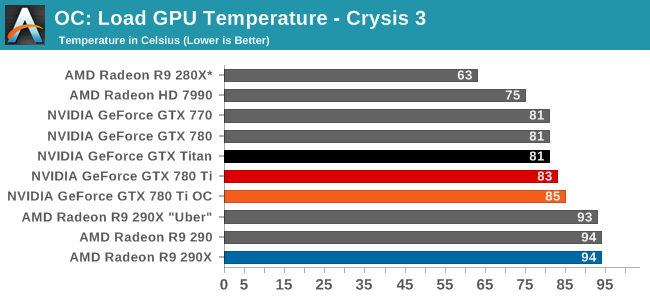
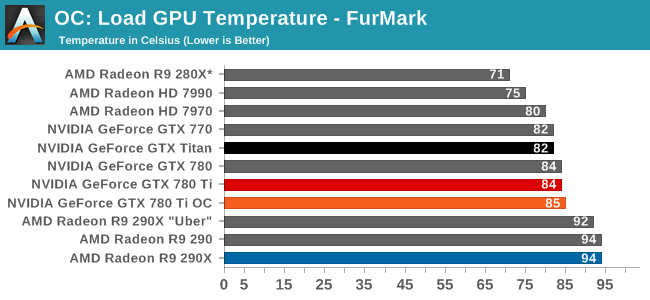
Despite the 95C temperature target we use for overclocking, the GTX 780 Ti finds its new equilibrium point at 85C. The fan will ramp up long before it allows us to get into the 90s.
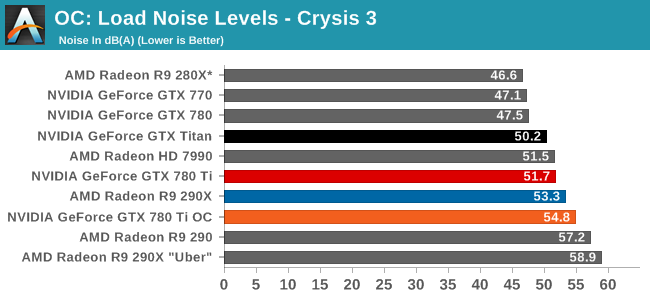
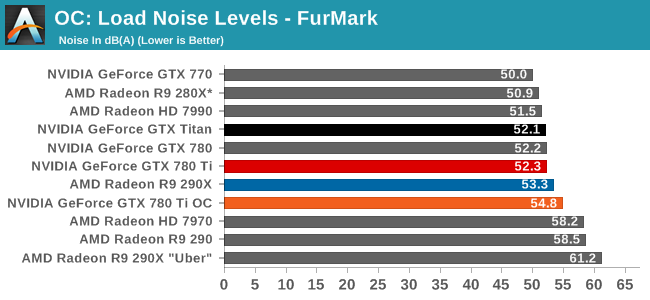
Given the power jump we saw with Crysis 3 the noise ramp up is surprisingly decent. A 3dB rise in noise is going to be noticeable, but even in these overclocked conditions it will avoid being an ear splitting change. To that end overclocking means we’re getting off of GK110’s standard noise efficiency curve just as it does for power, so the cost will almost always outpace the payoff on a relative basis.
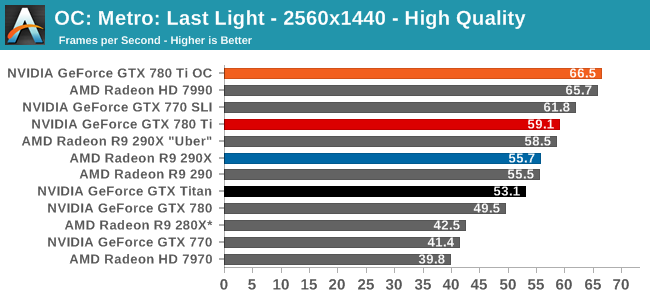
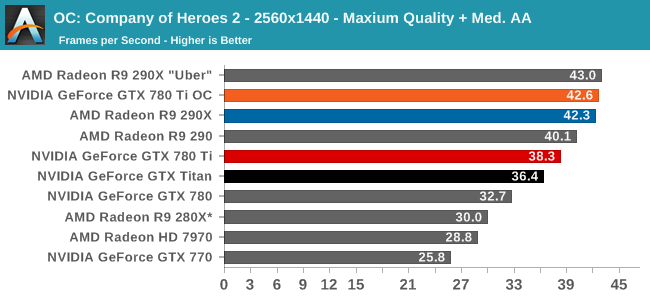
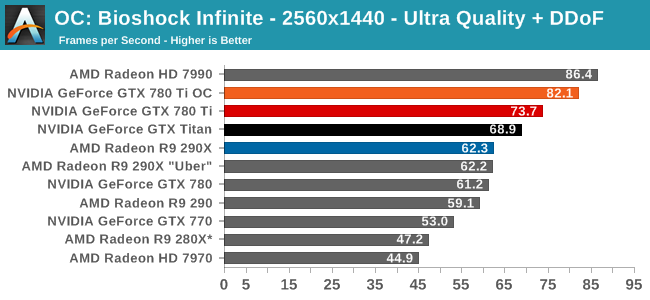
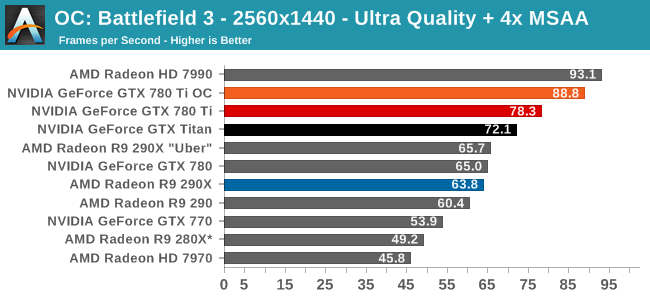
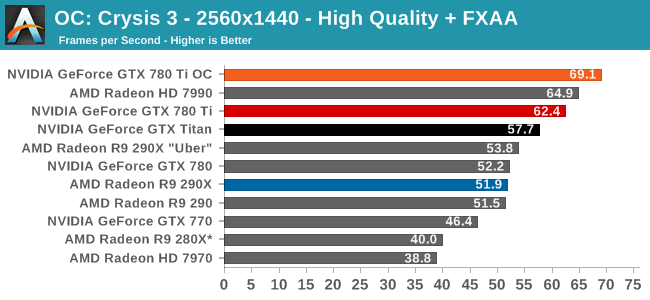
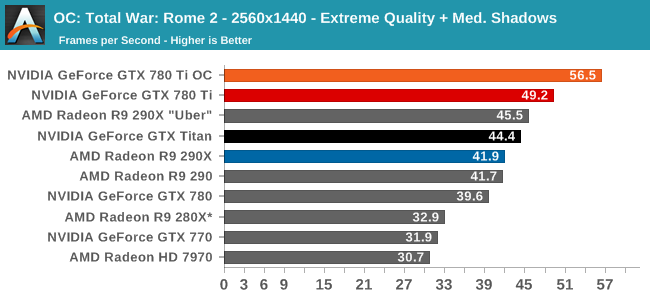
Finally, looking at gaming performance the the overall performance gains for overclocking are generally consistent. Between our 6 games we see a 10-14% performance increase, all in excess of the memory overclock and closely tracking the GPU overclock. GTX 780 Ti is already the fastest single-GPU card, so this only further improves its performance lead. But it does so while cutting into whatever is above it, be it the games where the stock 290X has a lead, or multi-GPU setups such as the 7990.
Final Words
Bringing this review to a close, after having seen NVIDIA upstage themselves a couple of times this year already with GK110, it’s admittedly getting a bit harder each time to write about NVIDIA’s flagship GPU. NVIDIA won’t break significant new ground just by refreshing GK110, but gradual performance increases in conjunction with periodic price drops have kept the market fresh while making NVIDIA’s high-end cards a bit faster and a bit cheaper each time. So in that respect we’re enthusiastic about seeing NVIDIA finally release a fully enabled GK110 GeForce card and the performance improvements it brings.
With that in mind, with the release of the GeForce GTX 780 Ti NVIDIA is once more left solidly in control of the single-GPU performance crown. It won’t quite get to claim a massive performance advantage over its closest competitors, but at the end of the day it’s going to be faster than any other single-GPU card out there. This will break down to being 11% faster than Radeon R9 290X, 9% faster than GTX Titan, and a full 20% faster than the original GTX 780 that it formally replaces.
To that end, while NVIDIA can still charge top dollar for their flagship card it’s a sign of the times and of the competition that they released their fully enabled GK110 part as a cheaper GTX 780 series card. At $700 it’s by no means cheap – and this has and always will be the drawback to NVIDIA’s flagships so long as NVIDIA can hold the lead – but it also means that NVIDIA does need to take AMD’s Radeon R9 290 series into account. As such the 290X and the GTX 780, though lesser performing parts, will remain as spoilers for GTX 780 Ti due to their better balance of performance and pricing. All the while GTX 780 Ti stands at the top of the heap for those who want the best.
Meanwhile we bid au revoir to the original GK110 GeForce card, GTX Titan. Though GTX Titan will still be on the market as an entry level compute card, it is finally dethroned as the fastest single-GPU gaming card in NVIDIA’s lineup. At least for the time being GTX Titan is still very secure in its place in the market as a compute card, and so there it will continue, a position that reflects the fact that there’s little need for NVIDIA to keep their gaming and compute products commingled together as a single product. Though we wouldn’t be the least bit surprised if NVIDIA made additional prosumer products of this nature in the future, as GTX Titan clearly worked out well for the company.
And though GTX Titan is falling off of our radar, we’re glad to see that NVIDIA has kept around Titan’s second most endearing design element, the Titan cooler. We won’t hazard to guess just how much it costs NVIDIA over a cheaper design (or what it adds to the final price tag), but with GTX 780 Ti NVIDIA has once again proven just how capable the cooler is when paired with GK110. Even with the slightly higher power consumption of GTX 780 Ti versus the cards that have come before it, thanks to that cooler GTX 780 Ti still hits an excellent sweet spot between performance and noise, offering the flexibility and simplicity of a blower without the noise that has traditionally accompanied such a cooler. And all the while still delivering more than enough performance to hold on to the performance crown.
Finally, let’s talk about SLI for a moment. Much like GTX Titan before it, GTX 780 Ti is so fast that it’s almost more than enough on its own for any standard single-monitor resolution. Even 2560x1440 with high settings isn’t enough to bog down GTX 780 Ti in most games, which makes a pair of GTX 780 Tis in SLI overkill by any definition. Properly using that much power requires multiple monitors, be it an Eyefinity/Surround setup, or more recently a tiled 4K monitor.
In either scenario a GTX 780 Ti is going to be a solid performer for those segments, but NVIDIA is going to have to deal with the fact that their performance advantage is going to melt away with the resolution increase. Right now a single GTX 780 Ti has a solid lead over a single 290X, but a pair of GTX 780 Tis is going to tie with a pair of cheaper 290Xs at 4K resolutions. And with 290X’s frame pacing under control NVIDIA no longer has that advantage to help build their case. GTX 780 Ti still has other advantages – power and noise in particular – but it does mean we’re in an interesting situation where NVIDIA can claim the single-GPU performance crown while the crown for the dual-GPU victor remains up for grabs. It's still very early in the game for 4K and NVIDIA isn't under any great pressure, but it will be an area of improvement for the next generation when Maxwell arrives in 2014.

